

Patterns of Force (episode)
- View history
The Enterprise , searching for a missing Federation historian, discovers that the historian has apparently contaminated the cultural development of the planet where he was assigned as a cultural observer to have it follow the societal path of Nazi Germany in the 1930s and '40s.
- 1.2 Act One
- 1.3 Act Two
- 1.4 Act Three
- 1.5 Act Four
- 2 Memorable quotes
- 3.1 Production history
- 3.3 Sets and costumes
- 3.4 Continuity
- 3.5 Cast and characters
- 3.6 Special visual effects
- 3.7 Controversies
- 3.8 Syndication Cuts
- 3.9 Remastered information
- 3.10 Video and DVD releases
- 4.1 Starring
- 4.2 Guest stars
- 4.3 Special appearance by
- 4.4 Co-stars
- 4.5 Uncredited co-stars
- 4.6 References
- 4.7 External links
Summary [ ]
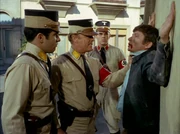
The National Socialist uniforms on Ekos .
The USS Enterprise heads for the planet Ekos to locate a missing cultural observer, Professor Dr. John Gill , Ph.D., a noted historian and brilliant history teacher who had been one of Kirk 's instructors at the Presidio Campus of the Academy . Spock , whose studies of Earth history were from a text that Gill had prepared, and McCoy reminisce about his (Gill's) style of approaching history as a matter of causes and motivations, rather than simply dates and events.
But while it is approaching the planet Ekos, the Enterprise is attacked by an old-style chemical rocket with a thermonuclear warhead – technology of whose development the planet is not yet supposed to be capable. Kirk has Chekov destroy the rocket with the ship's phasers . McCoy notes that the missile is generations ahead from where they should be technically. Kirk surmises that they may have had help – and Spock glances at Gill's photo.
Act One [ ]
Fearing that Gill's mission has been compromised in violation of the Prime Directive of non-interference with developing planets, Kirk and Spock beam down to Ekos. Before they do, they have McCoy insert subcutaneous emergency transponders , dependent on crystalline rubindium , into their forearms, to locate them for retrieval in the event they cannot use their communicators . Kirk orders that Scotty beam them up at the appointed time if they fail to contact the ship, no matter what their condition may be.
Upon beaming down, Kirk and Spock find a culture almost identical to that of Germany during its Nazi period of the 1930s and 40s , right down to the uniforms , the salutes, and the persecution of another ethnic culture – in this case, the inhabitants of the neighboring planet Zeon , and the concept of the Führer – John Gill himself. Stealing some SS uniforms , Kirk and Spock attempt to infiltrate the Führer's headquarters but are quickly captured when Spock is forced to remove his helmet, revealing his pointed Vulcan ears .
Act Two [ ]
Kirk and Spock are stripped to the waist and interrogated by an SS-Major , who lashes them cruelly with a whip; this, however, is interrupted by Chairman Eneg , who chides the SS guard for not realizing that punishment is effective for only just so long.
Left with their wounds still open, they find themselves imprisoned next to Isak , a Zeon underground member who explains how the Nazi movement began on Ekos, coinciding precisely with the time of Gill's arrival. Improvising a crude cutting-torch laser from the rubindium crystals from the transponders Kirk had had McCoy insert, at a subcutaneous level, into the skins of their forearms before beaming down, the trio then make their way to the SS laboratory, where Kirk pickpockets the keys from a guard; they manage to escape and retrieve two disassembled communicators from a SS laboratory. Kirk and Spock are able to steal SS uniforms again and leave, hauling out Isak in a stretcher. Later, the three return to the underground's base. There, Isak is greeted by his brother, Abrom , and told of the death of his fiancée , Uletta . In the midst of this, a squad of Ekosian stormtroopers (led by a woman) arrives, intent on arresting the entire lot. She apparently shoots Abrom dead and plans to "finish the job" by killing Kirk.
Act Three [ ]
When Kirk and Spock intervene to help the underground workers, it is revealed that the woman, Daras (who they recognized from a propaganda broadcast they viewed earlier), is an Ekosian member of the underground and the storming was a test to see if the two strangers could be trusted – once Kirk and Spock had responded to her apparent murder of Abrom by holding her at gunpoint, those gathered had realized that the two strangers were definitely on their side and had brought an end to the ruse. Kirk and Spock then reveal who they really are and why they are there.
The next opportunity to get to the Führer , they decide, is an upcoming speech in the chancellery in which Isak suspects war will be declared on Zeon — the " Final Solution ." To infiltrate the chancellery, Kirk and Spock accompany Daras and Isak (in Nazi disguise) to Führer headquarters posing as a Nazi documentary crew to try and reach Gill. Kirk, Spock, Isak, and Daras walk down a corridor pretending to film a record of the Führer's Final Solution speech. During this, Spock catches a glimpse of John Gill in a guarded room, seemingly drugged. Kirk tells Spock that they need Dr. McCoy. Kirk hides inside a cloakroom with Spock and asks Lieutenant Uhura to have McCoy beamed down from the Enterprise; however, they learn from Daras that the transmission (whose reception abord the Enterprise was bad, Uhura having described it as being "nine points into the low-frequency band") was traced, prompting a search party. Then the doctor joins them, dressed in a Nazi colonel's uniform. Once he has materialized fully, McCoy complains (mistakenly, as Spock explains) that the ship's computer had gotten the measurements on his right boot wrong, and that it is too tight. Spock perceives that McCoy is actually not pulling the boot on correctly, and explains how to do so. Once McCoy has complied, he wonders what is going on there. But before Kirk can answer him, two guards led by Chairman Eneg, barge into the cloakroom.
Act Four [ ]
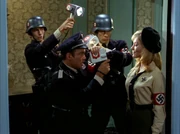
Kirk and Spock infiltrate the Nazi Headquarters
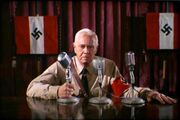
Gill as Fuhrer
With seconds to think, Kirk quickly says that the colonel has had too much to drink and that his presence in a drunken state would have embarrassed the Führer. Eneg accepts their explanation; he then explains that they are conducting a search and leaves. Spock is left puzzled at Eneg's apparent failure to recognize either of the two of them. With McCoy now joined with them, the group listens to a speech by Gill, followed by another from his deputy, Melakon , pledging the destruction of Zeon which is already taking place as he speaks. Meanwhile, the three are able to sneak into the broadcast booth. They there find Gill, but McCoy finds that Gill has been heavily drugged. McCoy does succeed in partially reviving Gill with stimulants, but Spock is forced use his mind-melding abilities to attempt to enable Gill to communicate.
Meanwhile, they overhear Melakon announce the commencement of the Final Decision , the genocidal invasion of Zeon. Daras pleads with Kirk to have the Enterprise intercept and destroy the invasion fleet as a last resort. Kirk is unwilling considering that would mean the deaths of thousands of Ekosians, as well as numerous underground Zeons who have infiltrated the Ekosian forces to attempt to interfere with their operations. Daras rationalizes that would be the lesser evil than to permit the murder of millions on Zeon, but Kirk is determined to help both populations who are equally victims of Gill's interference.
Eventually, Spock is able to establish contact with Gill and they learn the truth; Gill had taken matters into his own hands on Ekos, which he had found to be in a condition of anarchy . He had tried to help by encouraging the Ekosians to adopt Nazi Germany as a model, believing they could embrace its efficiency while avoiding its sadistic or xenophobic aspects. Kirk is appalled at Gill's naivete, but Spock points out that the Nazis's phenomenal recovery from Germany's economic and political collapse following World War I might have made it a compelling example, even for a gentle man such as Gill. Though Gill's plan to solve Ekos's problem of anarchy had worked at first, unfortunately, Melakon had seen an opportunity to take over. He had drugged Gill, installing him as a figurehead leader while keeping the real power in his own hands, and orchestrating the Ekosians's slide into violent militarism and racial hatred.
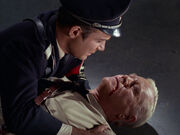
" Even historians fail to learn from history. They repeat the same mistakes. Let the killing end. Let… "
The search party, led by Eneg, steps into the room, and Kirk quickly pretends that they foiled an assassination attempt by Spock. They convince Eneg to present him to Melakon, which also convinces Isak that he is a member of the underground resistance. While they distract Melakon, Kirk struggles to revive Gill to a sufficiently coherent state. Gill is finally able to broadcast a message halting the invasion and declaring Melakon a traitor. Melakon takes an MP40 machine gun from a guard and shoots Gill through the broadcast booth curtain to silence him. Isak, in turn, shoots Melakon twice with a Luger, killing him instantly. As Gill dies in Kirk's arms, he admits to the captain that he had been wrong, and that the Prime Directive was the right way all along. Meanwhile, Eneg takes control of the government, declaring, " There has been enough killing. Now we'll start to live the way the Führer meant us to live. " He plans to go on the airwaves with Daras to offer a new way of life for both Ekosians and Zeons.
Back on board the Enterprise, Spock expresses confusion about how a man as logical as Gill could have committed such a mistake as emulating the Nazis. Kirk says that the real problem was not simply the Nazis themselves but giving any one individual so much power . McCoy remarks how (quoting John Dalberg-Acton, 1st Baron Acton ) power corrupts and absolute power corrupts absolutely; Spock dryly points out several examples from Earth history of just that mentality . Kirk cuts off their argument by saying, " Gentlemen, we've just been through one civil war; let's not start another. " Kirk then orders Ensign Chekov to plot a course and break out of orbit around Ekos as quickly as possible.
Memorable quotes [ ]
" Our missiles utterly destroyed the enemy. " " You look quite well for a man who's been utterly destroyed, Mr. Spock. "
" That helmet covers a multitude of sins. "
" You should make a very convincing Nazi. "
" Lieutenant? Better see a doctor. You don't look well. Your color... " " Yes. I shall tend to it, Major. " " Lieutenant! Your helmet. Remove it!"
" I…don't care if you hit the broad side of a barn! Just hurry, please. " " Captain, why should I aim at such a structure? " " Never mind, Spock. Just…get on with the job. "
" If we adopt the ways of the Nazis, we're as bad as the Nazis. "
" Captain, I'm beginning to understand why you Earth men enjoy gambling. No matter how carefully one computes the odds of success, there is still a certain… exhilaration in the risk. " " Very good, Spock. We may make a Human of you yet. " " I hope not. "
" Dr. McCoy is having difficulty with that uniform, sir. " " Send him down naked if you have to! Kirk out."
" Planet… fragmented… divided. Took lesson from… Earth history... " " But why Nazi Germany? You studied history; you knew what the Nazis were! " " Most efficient state… Earth ever knew… "
" Note the sinister eyes, and the malformed ears. Definitely an inferior race. "
"Even historians fail to learn from history…they repeat the same mistakes. Let the killing end, Kirk. Let--"
" For so long I've prayed for this. Now I'm sorry. " " So was he. "
" It is time to stop the bloodshed…to bury our dead. "
" Gentlemen, we've just been through one civil war; let's not start another. "
Background information [ ]
Production history [ ].
- Production number: #60352
- Story outline "Tomorrow the Universe" by Paul Schneider : 13 December 1966
- First draft teleplay: 20 January 1967
- Second draft teleplay: 3 March 1967
- Revised second draft: 1 June 1967
- Story outline "Patterns of Force" by John Meredyth Lucas : 7 June 1967
- Revised story outline: 19 June 1967
- Second revised story outline: 26 June 1967
- First draft teleplay: late- October 1967
- Second draft teleplay: November 1967
- Additional page revisions: 24 November 1967 , 27 November 1967 , 28 November 1967 , 30 November 1967
- Day 1 – 29 November 1967 , Wednesday – Paramount European Street backlot : Ext. City street , Street corner , Alley ; Paramount office buildings : Ext. Nazi party headquarters , Ext. Chancellery
- Day 2 – 30 November 1967 , Thursday – Desilu Stage 9 : Int. Transporter room , Underground room , Newscaster room
- Day 3 – 1 December 1967 , Friday – Desilu Stage 11 : Int. Ekosian jail , Jail cell
- Day 4 – 4 December 1967 , Monday – Desilu Stage 10 : Int. Nazi headquarters : Lower corridor, SS Labs, Broadcast room
- Day 5 – 5 December 1967 , Tuesday – Desilu Stage 10 : Int. Nazi headquarters : Interior corridor, Main room, Decoration area
- Day 6 – 6 December 1967 , Wednesday – Desilu Stage 10 : Int. Cloakroom , Desilu Stage 9 : Int. Bridge
- Original airdate: 16 February 1968
- First UK airdate (on BBC1 ): 3 August 1970
- First UK airdate (on ITV ): 23 January 1983
- Remastered airdate: 19 May 2007
- During the first season , Paul Schneider wrote a story outline entitled "Tomorrow the Universe" about the Enterprise encountering an alien planet adopting Nazi ideology and forming its own "Third Reich." Schneider began to develop the story further; however, when John Meredyth Lucas came up with his very similar idea of "Patterns of Force," it was deemed much better than Schneider's story, which was scrapped. ( These Are the Voyages: TOS Season Two )
- John Meredyth Lucas wrote this episode out of his fascination with the functioning of totalitarian regimes (especially Nazi Germany) and their ability to stay in power. [1] William Shatner quoted him to Chris Kreski, in Star Trek Memories , as saying that " it was fun to write a well-meaning Nazi, a guy who for the right cause completely fucked everything up. Y'know, we started with the question, 'How the hell did Nazism get past the shits and the street gangs and take root among the basically decent people? How did sane, reasonable adults come to buy into this bullshit?' The answer seemed to be because it was efficient and because, in a society beset by all kinds of problems, it may have seemed like a feasible necessity. So it becomes feasible, and the people take that leap. "
- An early draft of this episode had the source of cultural contamination arriving aboard a small " Ambassador -class" vessel called the Magellan . The name was later applied in TNG to the Ambassador -class of ships in the mid- 24th century .
- No stardate is logged in the episode. Bjo Trimble gave it a stardate of 2534.0 in her Star Trek Concordance , apparently using an earlier script version.
- Act II, Sc. 39-41. When Kirk and Spock exit the Chancellery they rounded a street corner and entered an alley. With the removal of this scene, two storm troopers and two trooper guards and apparently a Jeep did not appear in the episode as filmed.
- Act III, Sc. 46. When the cars pulled up at night and unloaded at the Chancellery, it was indicated that more officials were seen being dropped off before Kirk's group drive up in Sc. 47. Namely missing from the scene were two storm troopers, along with an SS officer general and his wife, whereas only the SS Gestapo general and his wife were seen entering as was noted.
- In addition to these scenes, the shooting schedule indicates that there were, among the reception party crowd, two waiters that appeared throughout, however no such individuals appeared in the episode.
- Eneg's name is an inside joke – it is " Gene " backwards. ( Star Trek Encyclopedia (2nd ed., p. 136)) The name "Zeon" is a take on "Zion," while "Abrom" corresponds to "Abraham", "Davod" to "David", and "Isak" to "Isaac"; "Daras", reversed, is almost "Sara".
- Star Trek 12 contains a novelization of this story by James Blish and J.A. Lawrence .
Sets and costumes [ ]
- The headquarters of the Nazi Party in this episode are the redecorated offices of Paramount Pictures during the 60s, including the building where Lucille Ball ran Desilu . Paramount office buildings were also used as locations in " Assignment: Earth ", and a short newsreel scene in " Bread and Circuses ".
- The underground area is the same set as was used for " The Devil in the Dark ".
- All the Nazi uniforms used in this episode are taken from Paramount's costume storage, and were previously featured in many of the studio's World War II-era films. [2] Many of them featured mismatched epaulets, collar tabs, and other rank-identifying insignia. However, McCoy's collar tabs, bearing a single silver oak leaf, correctly identify him as a colonel, as Kirk had ordered. Several uniforms, such as Kirk's and McCoy's, show cuffbands reading "Adolf Hitler". They represent members of the Leibstandarte Adolf Hitler , special bodyguards of the Führer.
- On the archive file photograph shown by Spock in the teaser, John Gill is wearing Commissioner Ferris 's jacket from " The Galileo Seven ".
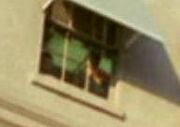
Two "Ekosians" look down from an upper window
- The front of the Ekosian Chancellery has all of its windows and shutters closed, for the real world reason that the actual building was an active office of Paramount Pictures with daily business going on inside while the film crew and actors were shooting the exterior on 29 November 1967 . ( To Boldly Go: Rare Photos from the TOS Soundstage - Season Two , p. 191) Even so, two individuals who appear to be curious Paramount Pictures employees can be seen looking down on the courtyard from an upper window.
Continuity [ ]
- This is the second mention of Nazi Germany in Star Trek , the first being in " The City on the Edge of Forever ". However, in " Mirror, Mirror ", Scott did compare Hikaru Sulu 's security system to "the ancient Gestapo".
- This episode discounts the previously established theory of Hodgkin's Law of Parallel Planetary Development , which was established to explain the similarities seen in " Bread and Circuses ". In this case, Kirk observes that " The chances of another planet developing a culture like Nazi Germany, using the forms, the symbols, the uniforms of twentieth century Earth are so fantastically slim, " which Spock described as " virtually impossible. " But John Gill had contaminated the development of Ekos's culture by introducing a modified version of Nazism to the planet, thereby breaching the Prime Directive , and hence this society did not evolve normally; thus, Hodgkin's Law might not have been applicable here.
Cast and characters [ ]
- George Takei does not appear in this episode.
- James Doohan only had one line in this episode, " Aye, sir. Whatever your condition. "
- This episode marks the only time, in any Star Trek series or film, that actor Leonard Nimoy is seen on camera not wearing a shirt. ( Star Trek: The Original Series 365 ) Unlike William Shatner, Nimoy refused Gene Roddenberry 's request to have his chest shaven. ( These Are the Voyages: TOS Season Two )
- Several of the cast, who dress up as Nazis in this episode, notably William Shatner and Leonard Nimoy , had Jewish backgrounds. On 1 December 1967 , newspaper and magazine photographers were invited to the set for publicity. Nimoy refused to have any pictures taken of him in Nazi uniform, as he was due to attend the Wilshire Blvd. Temple children's Hanukkah services later the same month, and did not want any possible controversies to arise. ( These Are the Voyages: TOS Season Two )
Special visual effects [ ]
- The attacking Ekosian missile on the viewscreen of Enterprise was reused footage of the Orion scout ship from " Journey to Babel " earlier in the season.
- In a change from the stock explosions used throughout the second season, an animated nuclear blast was created for this episode.
- V-2 rocket footage from World War II Germany is used in the newscast showing Ekosian missile.
- In one of the sequences of news footage, all of which consisted of stock shots and stock footage, a car with Adolf Hitler accompanied by soldiers is used to represent John Gill as the Führer on the planet Ekos . The sequence is a use of stock footage from Triumph of the Will , the infamous Nazi propaganda film for whose production Leni Riefenstahl was responsible.
Controversies [ ]
- Because the subject matter of the nation's Nazi past was deemed too serious and too sensitive a topic for light TV entertainment, this episode was withheld from broadcast in its two original runs by the German stations that aired TOS – the public ZDF network in the mid-1970s and the private Sat.1 network in the late 1980s/early 1990s – and resulted that "Patterns of Force" became the only Original Series episode not to be aired in Germany. Only in 1996 was the (dubbed) episode finally shown as "Schablonen der Gewalt" on German pay TV, shortly after the first time German-language release on VHS the year previously, and included on all subsequent DVD / Blu-ray Disc season sets. On 4 November 2011 it was finally shown on the public network channel ZDFneo as well. ( [3] ; TOS Season 2 DVD -special feature, "Red Shirt Logs: Bjo Trimble on censorship") During the first two German runs of TOS in the 1970s and 1980s, many former Nazis were still alive; during the third run in the 1990s, the former East Germany experienced a wave of neo-Nazi violence after the fall of the Berlin Wall.
- The episode's thesis, which Professor Dr. Gill espoused and which Spock corroborated, was that Nazi Germany was the "most efficient" state that was ever known in Earth history. But this notion, which was still widely accepted after World War II and even at the time of the episode's original broadcast on American television, has now been largely discredited. The historian William L. Shirer , in particular, has noted that the Nazi hierarchy was actually a tangled web of hostile competition, with many of its high officials being bitterly opposed to each other. Consequently, their respective jurisdictions often overlapped and/or collided. Hence, this conflict between these officials and their jurisdictions actually reduced or even, in some cases, completely negated governmental efficiency in Nazi Germany. The infighting that resulted from this exhausted the said officials too severely to enable them to close ranks against the Führer, Adolf Hitler .
- When first screened in the United Kingdom in 1970, the BBC partially edited the episode, with the scene in which Kirk and Spock are whipped being cut down. The cuts remained until the 1992-94 repeat run. [1]
Syndication Cuts [ ]
The episode received no formal syndication cuts but was frequently edited by local television stations to add more time for commercial breaks. Commonly edited scenes included:
- Extended interrogation scene with the SS Major questioning Kirk about his mission and who Spock is and where he comes from. In the edited version, all of this dialogue is cut, leading directly to Eneg's entrance right after the initial whipping scene is concluded.
- Extended scene of Kirk in disguise as a Nazi officer walking Spock and Isak to the SS research laboratory. This segment includes Kirk bumping into an SS soldier, stealing the lab key, and the soldier later realizing the key is gone. In the edited version, there is no explanation for why the soldier walks back into the lab after looking for something in his pockets.
- When Daras raids the resistance headquarters and shoots Abrom, a common edit to this scene was to cut to a commercial break after Daras says, "Do you know what we do to responsible Zeons?" without showing the shooting or her follow on dialogue about, "finishing the job".
- Lengthier conversations by the resistance team disguised as a Nazi camera crew, including Kirk instructing where to position the lights and a longer conversation about how Isak wants to simply kill John Gill immediately.
- Longer scene of Kirk slapping Gill and trying to wake him up out of his drug induced state.
Remastered information [ ]
The remastered version of "Patterns of Force" aired in many North American markets during the weekend of 19 May 2007 . While the episode required very few new effects, an entirely new shot of the Enterprise phasering the Ekosian warhead was substituted. In addition, Ekos was given a CGI-makeover as a more Earth-like planet, with new orbital shots of the Enterprise , and the rubindium crystal beam was refined.
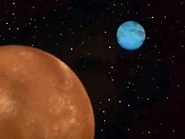
Video and DVD releases [ ]
- Original US Betamax release: 1986
- UK VHS release (two-episode tapes, CIC Video ): Volume 27 , catalog number VHR 2379, 2 July 1990
- US VHS release: 15 April 1994
- UK re-release (three-episode tapes, CIC Video): Volume 2.8, 21 July 1997
- Original US DVD release (single-disc): Volume 26, 19 June 2001
- As part of the TOS Season 2 DVD collection
Links and references [ ]
Starring [ ].
- William Shatner as Kirk
- Leonard Nimoy as Spock
- DeForest Kelley as McCoy
Guest stars [ ]
- Richard Evans as Isak
- Valora Noland as Daras
Special appearance by [ ]
- Skip Homeier as Melakon
- David Brian as John Gill
Co-stars [ ]
- James Doohan as Scott
- Nichelle Nichols as Uhura
- Patrick Horgan as Eneg
- William Wintersole as Abrom
- Gilbert Green as S.S. Major
- Walter Koenig as Chekov
- Ralph Maurer as S.S. Lieutenant
- Ed McCready as S.S. Trooper
- Peter Canon as Gestapo Lieutenant
- Paul Baxley as First Trooper
- Chuck Courtney as Davod
- Bart La Rue as Newscaster
Uncredited co-stars [ ]
- Benjie Bancroft as Ekosian brigadeführer
- William Blackburn as Hadley
- Ekosian lieutenant colonel
- Ekosian SS trooper
- Frank da Vinci as a Ekosian Reichsführer -SS
- Len Felber as Ekosian SA party official
- Adolf Hitler as Adolf Hitler (archive footage)
- Roger Holloway as Ekosian Reichsführer -SS
- Jeannie Malone as Ekosian SS General's wife
- Eddie Paskey as Zeon resistance member 2
- Basil Poledouris as SS trooper
- Robert Strong as SA member
- Robert Whitney as Ekosian SA official
- Ekosian SA stormtrooper 2 and 3
- Ekosian SS General's wife 2
- Ekosian SS Gestapo official 4 and 5
- Ekosian SS Officer official 2
- Ekosian SS troopers 1 , 3 , 4 , 5 , 6 , 7 , 8 , 9 , 10 , 11 , 13 , 14 , 15 , and 18
- Ekosian Wehrmacht generalmajor
- Ekosians at window
- Ekosians in newsreel
- SA official
- Zeon resistance member 3
References [ ]
20th century ; 1944 ; 2218 ; 2267 ; " Absolute power corrupts absolutely "; adventurer ; aggression ; Alexander the Great ; alien ; " all right "; anarchy ; animal ; antidote ; announcement ; architecture ; assassination ; assumption ; authority ; back ; bankruptcy ; barn ; base : betrayal ; blight ; body ; Bonaparte, Napoléon ; " Bones "; boot ; broadcast ; broadcast booth ; brother ; building ; Caesar, Julius ; café ; camera ; cancer ; car ; catalepsy ; cell ; Chairman of the Party ( Chairman ); chance ; Chancellery Detention Center ( prison ); circuit ; civil war ; cloakroom ; clock ; coat hanger ; colonel ; color ; Colt Police Positive ; coma ; communication range ; communicator ; conclusion ; consciousness ; contact ; conversation ; coordinates ; corporal ; country (aka state); courage ; crystal ; culture ; cultural contamination ; Cultural Museum ; cultural observer ; culture ; curtain ; Daras' father ; danger ; date ; dawn ; death ; declaration of war ; demonstration ; Deputy Führer ; destiny ; detection device ; detection range ; discipline ; disaster ; disease ; distance ; doctor ; door ; dosage ; dozen ; drugs ; ear ; Earth ; Earth history ; efficiency ; Ekos ; Ekos and Zeon system ; Ekosian ; Ekosian capital city ; Ekosian cities ; Ekosian Chancellery (Führer's Headquarters); Ekosian missile ; Ekosian ship ; emotionalism ; enemy ; error ; estimation ; event ; evidence ; evil ; excellency ; execution ; eye ; face ; Fatherland ; Federation ; figure ; figurehead ; Final Decision ; Final Solution ; flogging ; floor plan ; flush ; foot ; forehead ; frequency ; friend ; Führer ; Führer's Final Solution speech ( Führer's speech ); Führer's Special Documentary Corps ; gambling ; generation ; genetics ; German language ; Gestapo ; Gestapo Command Headquarters ; " get on with the job "; global domination ; God ; good ; greatness ; guard ; guide ; gun ; hall (aka corridor ); hand ; hate ; helmet ; historian ; historical computer ; Hitler, Adolf ; " hit the broad side of a barn "; hour ; Human (aka Earthmen ) Human history ; humanoid ; hypnosis ; idea ; imprisonment ; " in blazes "; " in good hands "; " in order to "; inferior race ; insanity ; instructor ; intercept course ; interrogation ; " in the dark "; " in the event "; Iron Cross ( medal or decoration ); " I see "; jacket ; job ; key ; kilometer ; laboratory ; laser ; leader ; Leader Principle ; Kuan, Lee ; lieutenant ; light ; light bulb ; logic ; low-frequency band ; machine gun ; major ; malformed ; maximum orbit ; maximum security ; measurement ; medi-comp ; Mercedes-Benz 200 Lang ; Mercedes-Benz 230 Lang ; Mercedes-Benz 770 ; Mercedes-Benz G4 ; microphone ; millimeter ; million ; mind ; minute ; mission ; mistake ; monster ; month ; mouth ; moving shot ; MP40 ; " multitude of sins "; " my goodness "; naked ; nation-state ; National Socialist Party ( Nazi , Nazi Party , Nazi movement ); National Socialist uniforms ; Nazi Germany ; Nazi salute ; " never mind "; non-interference directive ; " no matter what "; odds ; " of course "; official ; Old Earth calendar ; " once and for all "; order ; pain ; pallor ; " papers "; paradise ; party secretary ( secretary ); patriotism ; " pay the price "; persuasion ; phaser ; physics ; pig ( swine ); pistol ; place ; plan ; power ; power ; present ; pride ; principle ; probe ; problem ; professor ; projectile weapon ; punishment ; psychosis ; physics ; question ; race ; racial purity ; radio ; Ramses ; range ; reparations ; report ; result ; risk ; rocket ; room ; rubindium ; sadism ; salute ; saying ; search ; semi-divine detachment ; sentence ; sin ; smile ; sleep ; soldier ; space fleet ; spacecraft ; spaceman ; spat ; speech (ability); speech (oration); spy ; SS ; SS weapons laboratory ; standard orbit ; " stand by "; standing order ; Starfleet ; Starfleet Academy ; Starfleet communications (aka Starfleet channel ); steal ; stimulant ; stranger ; streets ; stupidity ; subcutaneous transponder ( transponder ); suicide ; swastika ; symbol ; tank ; " thank God "; " the lesser of two evils "; thermonuclear missile ; thermonuclear warhead ( warhead ); thing ; thought ; thousand ; threat ; toe ; traitor ; transmitter ; transponder ; treatment ; troop ; Uletta ; Underground ; uniform section ; union ; unit ; United Space Ship ; viewscreen ; Volkswagen Beetle ; Volkswagen Kübelwagen ; Vulcan mind probe ; Vulcan neck pinch ; wall ; Walther P38 ; weapon ; wife ; whip ; Zeon ; Zeon colony ; Zeon (planet) ; Zeon ship ( Zeon spacecraft )
External links [ ]
- "Patterns of Force" at StarTrek.com
- " Patterns of Force " at Memory Beta , the wiki for licensed Star Trek works
- " Patterns of Force " at Wikipedia
- " Patterns of Force " at MissionLogPodcast.com , a Roddenberry Star Trek podcast
- ↑ https://www.denofgeek.com/tv/star-trek-looking-back-at-the-bbcs-ban-and-censorship/
- 3 Ancient humanoid
Star Trek (TV Series)
Patterns of force (1968), full cast & crew.

Directed by
Writing credits , cast (in credits order) verified as complete , produced by , music by , cinematography by , editing by , casting by , art direction by , set decoration by , costume design by , makeup department , production management , second unit director or assistant director , art department , sound department , special effects by , visual effects by , camera and electrical department , costume and wardrobe department , music department , script and continuity department , additional crew .
Release Dates | Official Sites | Company Credits | Filming & Production | Technical Specs
Contribute to This Page
- Full Cast and Crew
- Release Dates
- Official Sites
- Company Credits
- Filming & Production
- Technical Specs
- Plot Summary
- Plot Keywords
- Parents Guide
Did You Know?
- Crazy Credits
- Alternate Versions
- Connections
- Soundtracks
Photo & Video
- Photo Gallery
- Trailers and Videos
- User Reviews
- User Ratings
- External Reviews
- Metacritic Reviews
Related Items
- External Sites
Related lists from IMDb users

Recently Viewed
Navigation menu
- Mission Logs
- Chronologies
- Library Computer
Patterns of Force (Episode)

Stardate 2534.0 : The Enterprise is sent to planet Ekos to investigate a disappearance of Federation historian John Gill.
Arriving at the planet Ekos , the Enterprise is fired upon by atomic missiles , although records indicate that the planet does not possess such technology. Kirk and Spock beam down to investigate. In an effort to centralize Ekos' political structure, Federation cultural observer John Gill — who was a teacher of Kirk's at Starfleet Academy — has recreated a frightening imitation of Nazi Germany . Intending only to imitate the efficient Nazi bureaucracy, Gill has been subjugated by his aide, Melakon , who runs Ekos as a police state, using the drugged Human as a figurehead. Kirk works with the underground of Zeon , a nearby planet whose inhabitants have become targets of Melakon's persecution. Infiltrating Melakon's headquarters as Gill is about to deliver a rigged speech on television , Kirk and McCoy revive the historian. Gill is able to denounce the regime before Melakon kills him. The Ekosians turn on Melakon, and Gill's misguided experiment comes to an end.
Image Gallery

SS Lieutenant

SS torturer

Gestapo lieutenant

disassembled communicator

Nazi Party headquarters
Related Data
Created by Gene Roddenberry
Starring William Shatner
Also Starring Leonard Nimoy as Mr. Spock and DeForest Kelley as Dr. McCoy
Written by John Meredyth Lucas
Directed by Vincent McEveety
Produced by John Meredyth Lucas
Executive Producer Gene Roddenberry
Associate Producer Robert H. Justman
Guest Stars Richard Evans as Isak and Laura Noland as Daras
Special Appearance by Skip Homeier as Melakon and David Brian as John Gill
James Doohan … Scott Nichelle Nichols … Uhura Patrick Horgan … Eneg William Wintersole … Abrom and Gilbert Green … SS Major Walter Koenig … Chekov Ralph Maurer … SS Lieutenant Ed McReady … SS Trooper Peter Cannon … Gestapo Lieutenant Paul Baxley … First Trooper Chuck Courtney … Davod Bart La Rue … Newscaster
Script Consultant D.C. Fontana
Assistant to the Producer Edward K. Milkis
Theme Music by Alexander Courage
Music Composed and Conducted by George Duning
Director of Photography Jerry Finnerman
Art Director Walter M. Jefferies
Film Editor … Fabien Tordjmann Unit Production Manager … Gregg Peters Assistant Director … Phil Rawlins Set Decorator … John M. Dwyer Costumes Created by … William Ware Theiss Photographic Effects … Westheimer Company Sound Effects Editor … Douglas H. Grindstaff Music Editor … Jim Henrikson Re-Recording Mixer … Elden E. Ruberg , C.A.S. Production Mixer … Carl W. Daniels Script Supervisor … George A. Rutter Casting … Joseph D'Agosta Sound … Glen Glenn Sound Co. Makeup Artist … Fred B. Phillips , S.M.A. Hair Styles … Pat Westmore Gaffer … George H. Merhoff Head Grip … George Rader Property Master … Irving A. Feinberg Special Effects … Jim Rugg Key Costumer … Ken Harvey
A Paramount Production In Association With Norway Corporation
Executive in Charge of Production Herbert F. Solow
- Prime Timeline
- 23rd Century
- Privacy policy
- About Trekipedia
- Disclaimers
- Login / Create Account
Star Trek: The Original Series
Patterns of Force
Cast & crew.
Valora Noland
Richard Evans
David Brian
Skip Homeier
Patrick Horgan
Information
© 2009 CBS Corp.
Accessibility
Copyright © 2024 Apple Inc. All rights reserved.
Internet Service Terms Apple TV & Privacy Cookie Policy Support
- Show Spoilers
- Night Vision
- Sticky Header
- Highlight Links

Follow TV Tropes
http://tvtropes.org/pmwiki/pmwiki.php/Recap/StarTrekS2E21PatternsOfForce
Recap / Star Trek S2 E21 "Patterns of Force"
Edit locked.

Original air date: February 16, 1968
The Enterprise crew are headed off to the planet Ekos to pick up famed cultural observer John Gill, with whom the Federation has lost contact for some time. In a bit of Hero Worship , McCoy and Spock share a poignant discussion about their relationship with the man, with Spock admiring Gill's take on historical events as causes and effects rather than that boring system of dates and events that normal history teaches us.
Things start to get interesting, though, when a nuclear interplanetary missile is launched at the ship from Ekos — technology that shouldn't even be possible for the planet's primitive inhabitants.
Taking high orbit over Ekos, Kirk and Spock beam down in local attire to see what they can find about this turn of events, only to be more baffled when a televised message reveals that not only is the planet an exact duplicate of Nazi Germany , but that John Gill is the planet's Führer. Ambushing a pair of Nazi soldiers in order to dress as the enemy , they attempt to infiltrate the Führer headquarters to get some answers, but are caught and brought in for interrogation. There, they meet a Zeon prisoner by the name of Isak, who explains that the planet had actually been a rather nice place to visit, during the initial rule of the Führer, but turned into a nightmare once the old Nazi prejudices came up - now the Ekosians are on their way to eradicating the inhabitants of their sister planet Zeon in much the same way the Nazis tried to eradicate the Jews and other hated minorities. Using crystal transponders embedded into their flesh, Kirk and Spock manage to free themselves and Isak, and escape into the underground that Isak is a member of. However, before they can prove to the underground that they're friendly, a Nazi task force led by a young woman named Daras — crowned a hero of the fatherland in the same transmission that revealed Gill as the Führer — comes in and shoots one of the underground, threatening to kill them all if they don't comply.
Kirk manages to overpower Daras, but is prevented from killing her by the man she shot; turns out, Daras is a member of the underground, and the raid was an elaborate test to see if Kirk and Spock are friendly. Deciding things are screwed up enough without worrying about the Prime Directive , Kirk comes out and tells the group that Gill is an alien sent to observe Ekosian culture, and that something has gone horribly wrong to make him interfere with the planet's development so radically. With the underground's help, Kirk and Spock break into the headquarters, once more, just in time to catch a televised message from Gill seemingly announcing a " Final Solution " to eradicate Zeon once and for all. However, with the help of a very reluctant (and late to the party) McCoy, they're able to determine Gill is actually being drugged and kept in a stupor; a quick Mind Meld further reveals his second-in-command Melakon has taken over, using him as a figurehead while he wields the real power behind the swastika.
With some drugs to help stimulate him into light consciousness, they're able to get an answer to the multi-million-credit question: why did Gill break the Prime Directive and use Nazi Germany as a template for his interference? As it turns out, Gill just couldn't stand idly by as the Ekosian people were tearing themselves apart by their barbarism, and thought the efficiency of the Nazis could be used to civilize them, if malice wasn't put to the fore, and it worked until Melakon took over. Eventually, Kirk manages to get Gill lucid enough to cancel the Final Solution order before Melakon kills him, who is in turn killed himself. With the Nazi planet now leaderless , all the other Nazis just step down without a fuss, and it'll be a breeze for La Résistance and Zeon to reform a whole planet full of Nazis filled with anti-Zeon propaganda.
The Fan Nickname for this episode is " The One With… The Nazi Planet ".
Tropes of Force:
- Actual Pacifist : The Zeon are so peaceful that Isak worries that they'll fall to the Ekosians without a fight. Although Isak himself downplays it, as "what he saw in the streets" made him think that he could kill because it was necessary to survive, and indeed he was willing to do so if the cause was important enough (such as murdering the Fuhrer, John Gill, to stop the slaughter of his people). And he does; after John Gill reveals Melakon as a traitor and Melakon guns him down, Isak immediately shoots him where he stands.
- Spock's conception of History was already outdated in the '60s. Spock: What impressed me most was his treatment of Earth history as causes and motivations rather than dates and events.
- Kirk repeatedly refers to the SS uniforms as "Gestapo," which was the plain-clothes secret police. Gestapo personnel did wear SS uniforms in occupied territory to avoid being mistaken for civilians, but this isn't occupied territory.
- Blatant Lies : The Nazis announce that one of their missiles utterly destroyed an enemy spaceship — that ship being the very un -destroyed Enterprise . Kirk: You look quite well for a man who's been utterly destroyed, Mr. Spock.
- Beethoven Was an Alien Spy : Inverted! A human poses as an alien and becomes someone of historical significance.
- Broken Pedestal : Kirk is aggrieved to find that his teacher has become another Hitler. The pedestal is repaired when he gets out of his drug induced haze and denounces the regime, just before dying in Kirk's arms.
- Chairman Obvious : Chairman Eneg demonstrates his firm grasp of the obvious. Eneg: You are not from Zeon. Spock: Obviously.
- Cycle of Revenge : Averted at the end — Melakon kills Gill, while Isak kills Melakon. When another soldier raises his rifle at Isak, Eneg stops him and declares "There has been enough killing."
- Dated History : It was often thought for a while after World War II that Nazi Germany was efficiently run because of its fast ascension from military impotency, collapse of national morale and economic devastation to a world power and scary conquering machine. As more and more research has unveiled, the Third Reich sacrificed any hope of long-term efficiency in order to implement their short-term solutions, and even those needed to be augmented by expansion into the resources of Austria and Czechoslovakia to work. Ironically, this would perfectly tie it back in with their lebensraum attempt into Zeon. The Nazi hierarchy was also hampered by being one of the most backstabbing in history, full of Interservice Rivalry .
- Daras is working with the resistance because she believes the Nazi leadership has gone off the rails, a trait she shares with her father, who helped integrate her into the leadership by having them pretend that he'd denounced her.
- Late into the episode, Isak tells Kirk and company that Eneg is one of them, which explains why when he was tasked with finding a spy within the building and stumbled upon Kirk and company earlier (up to no good, certainly, but even being found alone in a room would've been suspicious at that point), he pretended he'd never seen them before/'bought' their fairly obvious Blatant Lies .
- Delayed Reaction : Even after beaming down in an SS uniform and struggling to get his boot on, it takes Bones about half a minute to realize that everyone is wearing Nazi uniforms and ask what the hell is going on.
- Diagnosis: Knowing Too Much : After Spock is able to break through Gill's heavy drugging, Melakon tries to play off Gill's off-schedule attempt to regain control as being tired and ill. Unfortunately for Melakon, Gill has just enough strength to call-off the attack and expose Melakon as the usurping traitor. Unfortunately for Gill , Melakon empties a magazine of automatic rifle rounds into the broadcast booth, mortally wounding Gill. One of the rebels shoots and kills Melakon in-kind.
- Does This Remind You of Anything? : Gene's not too subtle about anything in this episode. The Space Nazis' scapegoats come from the planet Zeon (Zion) and have names like Isak and Abrom (Isaac and Abraham). The way Melakhon talks about how Spock's physical features are obvious evidence of inferiority also evokes Nazi eugenics.
- Dressing as the Enemy : Kirk and Spock steal the uniforms of two Nazis for a disguise. Unfortunately, they make a mistake in military protocol bad enough to arouse a Nazi officer's suspicions enough for him to order Spock to take off his helmet. When Spock's ears are exposed, both he and Kirk know full well they are screwed .
- Excuse Plot : Meta-wise, at any rate. The episode pretty much only exists because the studio had a bunch of Nazi uniforms already available from various movies so the show could skip making costumes for a week.
- Failed a Spot Check : Kirk and Spock walk right by a Gestapo officer that is standing in broad daylight and are then somehow surprised when he "jumps" out to capture them.
- Final Solution : The plan for a Final Solution is announced midway through the episode.
- Forgotten Phlebotinum : Gee, those Transponders might have come in handy in any of the other 78 episodes in which the landing party's communicators get taken away.
- Hollywood Military Uniform : Many of the Nazi uniforms have inaccurate or mismatched rank insignia compared to history. This could be chalked up to Gill (or the Paramount costume department) not being too fussy about the finer details.
- Human Ladder : Kirk and Spock make one in their escape attempt. Given that they've both been whipped, it's very uncomfortable for the captain, who's bearing the first officer.
- Idiot Ball : A massive one for John Gill for coming up with Fascism as the best way to unite a planet peacefully (which he wasn't even supposed to do; he was supposed to simply observe the Ekosians, not violate General Order One), while he already has an excellent example of one in the Federation itself (which has united Earth for decades already). Though it's interesting to note it worked, as merely an efficient state rather than 'evil Nazis', the latter of which only happened when Melakon drugged him and changed things. Even still, he himself notes in his dying moments that 'even historians can fail to learn from history'.
- Inexplicable Cultural Ties : Not the case, which is noteworthy because that is often forgotten in summaries of TOS, and because the fact that it looks like this is one of the main things that tips off the Enterprise crew that something is seriously wrong despite the fact that only four episodes later they will react to another planet being very similar to an Earth society (in that case The Roman Empire ) complete with names and symbols by handwaving it as just an example of natural parallel development.
- I Owe You My Life : Isak, after Kirk and Spock escape with him.
- Killed Mid-Sentence : Gill is exposing Melakon's treachery, calling off the attack on Zeon, and promising reparation when Melakon shoots him.
- Know-Nothing Know-It-All : Melakon attempts to analyze Spock's unusual appearance based on the regime's racial theories and declares that he exhibits "a low forehead denoting stupidity" and "the dull look of a trapped animal". Big mistake.
- La Résistance : The Ekosians who disagree with the government's plan to wipe out Zeon.
- The Man Behind the Man / The Man in Front of the Man : Melakon, officially the Führer's second-in-command, combines both tropes when he's revealed to be the one behind the Zeon purges.
- Man Hug : Isak shares one with his brother Abrom after his escape.
- Meaningful Name : Zeon, clearly referring to Zion, the Jewish promised land. Also Isak (Isaac), Abrom (Abraham) and Davod (David) are all based on Old Testament persons. Daras is Sara backwards with an extra letter, and also OT. Eneg is Gene backwards.
- Meaningless Meaningful Words : John Gill's New Era Speech . Spock points out that it follows no logical pattern, and considering the man's heavily drugged, it's little wonder.
- The Mole : Daras and Chairman Eneg are both introduced as loyal servants of the regime before revealing that they're working with the resistance.
- Mugged for Disguise : Two Nazi officers were nerve-pinched for disguises.
- Naked People Are Funny : When Kirk asks why Bones hasn't beamed down yet, he's told the Doctor is having trouble getting his Nazi uniform on. Kirk says "I don't care if you have to send him down naked, just get him down here!" Cue Kirk's reaction when he hears the transporter beam whine start immediately after this. (Don't worry ... it was the boot the Doc was having trouble with.)
- No Endor Holocaust : The ending implies that there won't be any anti-Zeonite sentiments left under the population, and that the army leadership will politely step down from power. Given Earth's many examples of what can happen when a political dictatorship is decapitated (as both the puppet leader and actual leader die), things could have gotten ugly very fast . Mind you, a civil war may be bad but might help it ease out of Nazification.
- Non-Lethal Deadly Weapon : Daras fires a gun at Abrom and kills him. After Kirk and Spock grab her, Spock takes her gun away from her. Abrom then gets up, revealing that her gun was filled with blanks. Spock points the gun at Daras, even though it can't shoot her. Perhaps justified by the fact that even blanks can cause serious injury from the range he is threatening her with it. (And from the look on her face when this happens, she agrees.)
- No One Sees the Boss : Because the boss has been drugged into catatonia, and The Dragon has taken over.
- No Swastikas : Averted.
- Percussive Pickpocket : Kirk stumbles into a guard in a corridor; after apologizing and moving on, he reveals to his companions that he lifted the guard's keys.
- Planetary Nation : Melakon is trying to make the planet this.
- Planet of Hats : People from the planet Zeon are identified and arrested because they wear civilian clothes. All the Ekosians we see on screen are Nazi officials.
- Pseudo-Crisis : Our heroes are surrounded by Nazis! (Ad break) But they're with the resistance, so it's okay!
- Puppet King : Melakon keeps Gill drugged and only trots him out to deliver the occasional speech.
- Reports of My Death Were Greatly Exaggerated : While planetside, Kirk and Spock hear a news report claiming the Ekosians "utterly destroyed" the enemy spacecraft. Kirk jokes that Spock looks quite healthy for someone who's been utterly destroyed.
- Sdrawkcab Name : Chairman Eneg, probably .
- Shirtless Scene : Kirk and Spock when they get whipped. Spock's scars are tinted green.
- Staged Shooting : Used to see which side Kirk and Spock are really on.
- The Ekosian missile on the viewscreen is recycled footage of the Orion scout ship from " Journey to Babel ."
- Shots taken from the 1935 Nazi propaganda film Triumph of the Will are used in the Ekosian newsreel. Adolf Hitler is clearly visible, arriving in a car in one of these.
- Subterfuge Judo : When Kirk and Spock beam down, they steal some SS uniforms, and intend to waltz right into the Chancellery (Main Headquarters) undercover, except Spock and Kirk do not salute an SS Major properly, and...: SS Major: Lieutenant! Have you forgotten how to salute? [Spock salutes] Your papers. Kirk: Your orders, Lieutenant. He wants to see your orders in the jacket. [Spock begins to open the pocket on his uniform coat] The Lieutenant is a little dazed. He captured several Zeons note (The persecuted ethnicity on the planet) singlehanded. One of the pigs struck him before he dropped. I promise that pig will never get up again. SS Major: Good work, Lieutenant. All: Hail to the Führer. Kirk: This is a day to remember, Major! [They start to walk away] SS Major: Lieutenant? Better see a doctor. You don't look well. Your color. Spock: Yes. I shall tend to it, Major. [A pause, the SS Major eyes Spock a bit] SS Major: [slightly more forceful, suspicious] Lieutenant! Your helmet. Remove it! Kirk: We have urgent business with the Führer. [starts to turn away to enter the Chancellery] SS Major: [steadfastly forceful] LIEUTENANT! Remove your helmet!!! [The entrance guards train their rifles right on Spock's head, and with no other choice, Spock slowly takes off his helmet, revealing his pointed ears.]
- Take a Third Option : When Ekosians launch the invasion fleet against Zeon, Daras, the Ekosian resistance fighter, pleads with Capt. Kirk to have the Enterprise destroy it to save Zeon, saying that the loss of Ekosian lives is the lesser of two evils. Kirk balks at that and manages to get Gill to cancel the invasion instead.
- McCoy and Spock both comment that Gill's speech sounds incoherent, just a babble of random sentences. And it turns out the Fuhrer was, in fact drugged. Thing is, it doesn't sound too different in structure from a real Hitler speech.
- Melakon is at one point invited to do racial analysis on Mr. Spock. All of his summations are hilariously wrong about Vulcans.
- Torture Is Ineffective : Chairman Eneg puts a stop to the SS Major torture interrogation of Kirk and Spock claiming that is because he knows it's inefficient (the real reason is because he's The Mole ). SS Major: Excellency, give me a few minutes with them. I promise you, I'll have— Chairman Eneg: You've had a few minutes without result. The trouble with you SS is that you don't realize that punishment becomes ineffective after a certain point. Men become insensitive.
- Trojan Prisoner : A couple of times when Kirk and Spock (and later Isak too) don't have enough uniforms to go around, they use the "just taking this prisoner for interrogation" method to get past guard posts.
- Well-Intentioned Extremist : Yes, Gill actually had good intentions when he recreated Nazi Germany. (As in, their society was considered to be in poor shape anyway , so why not model their government after a different society instead? It just happen to fall apart in a different way....)
- Whip of Dominance : The SS Major is a cruel and sadistic Nazi officer who carries a cat o' nine tails, and personally uses it on Kirk and Spock when interrogating them. He clearly wants to whip them more, but Chairman Eneg puts a stop to it while criticizing the Major for his sadistic inefficiency and saying that Torture Is Ineffective after a certain point.
- You Have GOT to Be Kidding Me! : Kirk is exasperated when Spock's Blunt Metaphors Trauma keeps him on Kirk's post-whipped back for a little too long. Kirk : I ... don't care if you aim at the broad side of a barn. Just hurry, please. Spock : Captain, why would I aim at such a structure? Kirk: [ Sighs ] Never mind, Spock, just ... get on with the job.
Video Example(s):
Star trek nazi planet.
Kirk and Spock discover a planet of human-like aliens who have adopted the aesthetic and the ideology of the Nazis.
Example of: Putting on the Reich
- Star Trek S2 E20 "Return to Tomorrow"
- Recap/Star Trek: The Original Series
- Star Trek S2 E22 "By Any Other Name"
Important Links
- Action Adventure
- Commercials
- Crime & Punishment
- Professional Wrestling
- Speculative Fiction
- Sports Story
- Animation (Western)
- Music And Sound Effects
- Print Media
- Sequential Art
- Tabletop Games
- Applied Phlebotinum
- Characterization
- Characters As Device
- Narrative Devices
- British Telly
- The Contributors
- Creator Speak
- Derivative Works
- Laws And Formulas
- Show Business
- Split Personality
- Truth And Lies
- Truth In Television
- Fate And Prophecy
- Edit Reasons
- Isolated Pages
- Images List
- Recent Videos
- Crowner Activity
- Un-typed Pages
- Recent Page Type Changes
- Trope Entry
- Character Sheet
- Playing With
- Creating New Redirects
- Cross Wicking
- Tips for Editing
- Text Formatting Rules
- Handling Spoilers
- Administrivia
- Trope Repair Shop
- Image Pickin'
Advertisement:
How well does it match the trope?
Example of:
Media sources:
11,241--> Report
Memory Beta, non-canon Star Trek Wiki
A friendly reminder regarding spoilers ! At present the expanded Trek universe is in a period of major upheaval with the continuations of Discovery and Prodigy , the advent of new eras in gaming with the Star Trek Adventures RPG , Star Trek: Infinite and Star Trek Online , as well as other post-57th Anniversary publications such as the ongoing IDW Star Trek comic and spin-off Star Trek: Defiant . Therefore, please be courteous to other users who may not be aware of current developments by using the {{ spoiler }}, {{ spoilers }} OR {{ majorspoiler }} tags when adding new information from sources less than six months old (even if it is minor info). Also, please do not include details in the summary bar when editing pages and do not anticipate making additions relating to sources not yet in release. THANK YOU
Patterns of Force
- View history
"Patterns of Force" was the 52nd episode of Star Trek: The Original Series , the 23rd episode of the show 's second season, first aired on 16 February 1968 . The episode was written by John Meredyth Lucas MA , directed by Vincent McEveety MA and novelized in Star Trek 12 by James Blish and J.A. Lawrence .
- 2.1.1 Episode characters
- 2.1.2 Novelization characters
- 2.2 Starships and vehicles
- 2.3.1 Shipboard areas
- 2.3.2 Planetary locales
- 2.4 Races and cultures
- 2.5 Technology and weapons
- 2.6 Materials and substances
- 2.7 States and organizations
- 2.8 Ranks and titles
- 2.9 Other references
- 3 Chronology
- 4.1.1 Novel adaptations
- 4.1.2 Video releases
- 4.2.1 Episode images
- 4.2.2 Adaptation images
- 4.3.1.1 Translations
- 4.4 External link
Summary [ ]
James T. Kirk , Spock and Leonard McCoy must stop a Nazi -like invasion of the planet Zeon by planet Ekos and Federation observer John Gill is the Ekosians ' Führer !
References [ ]
Characters [ ], episode characters [ ], novelization characters [ ].


Starships and vehicles [ ]

Locations [ ]
Shipboard areas [ ], planetary locales [ ], races and cultures [ ], technology and weapons [ ], materials and substances [ ], states and organizations [ ], ranks and titles [ ], other references [ ], chronology [ ], appendices [ ], related media [ ].
- According to Decipher RPG module : Worlds , Gill's headquarters was located in the city of Ekosis , the capital city of an historic state , the Thalossis kingdom .
- Depicts the coordinates and maps of the M43 Alpha system and Ekosian homeworld , as well as the Zeon history and clothing.
- Depicts the coordinates and maps of the M43 Alpha system and Ekosi/Zeosian homeworlds .
Novel adaptations [ ]
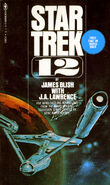
Video releases [ ]
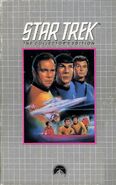
Episode images [ ]
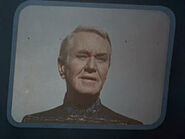
Adaptation images [ ]
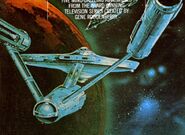
Connections [ ]
Timeline [ ], translations [ ], external link [ ].
- " Patterns of Force " article at Memory Alpha , the wiki for canon Star Trek .
- Patterns of Force article at Wikipedia , the free encyclopedia.
- 1 The Chase
- 2 Preserver (race)
- 3 Totality (Andromeda)
The Creative Life Adventure
Living a creative life
Boldly Rewatching the Voyages: Patterns of Force
(Note: If you haven’t read it yet, my introductory post on this Star Trek: The Original Series rewatch is a good place to start.)
Original Air Date: February 16, 1968
Crew Death Count: 0
Bellybuttons: 2 (Kirk and Spock get topless in prison)
It would be tempting to call “Patterns of Force” the lowest moment of the original series, if we didn’t still have “The Omega Glory” to suffer through. Because of its Nazi imagery and one character, albeit a drug-addled crackpot, describing the Third Reich as efficient, “Patterns of Force” did not air in Germany in any form until 1995. Lucky devils. This week the Enterprise goes in search of Federation historian John Gill ( David Brian ), who was observing the planet Ekos but hasn’t been heard from in six months. The crew – really just Kirk, Spock, and McCoy – learns that Gill has significantly violated the Prime Directive on Ekos, giving rise to a Nazi regime obsessed with killing inhabitants of nearby Zeon. The Ekosians are about to implement the Final Solution Decision, exterminating all Zeons, unless Kirk and company can escape the Nazi clutches and get to the Führer (seriously), Gill himself. The whole Nazis in Space premise makes Space Moby Dick look like a work of genius.
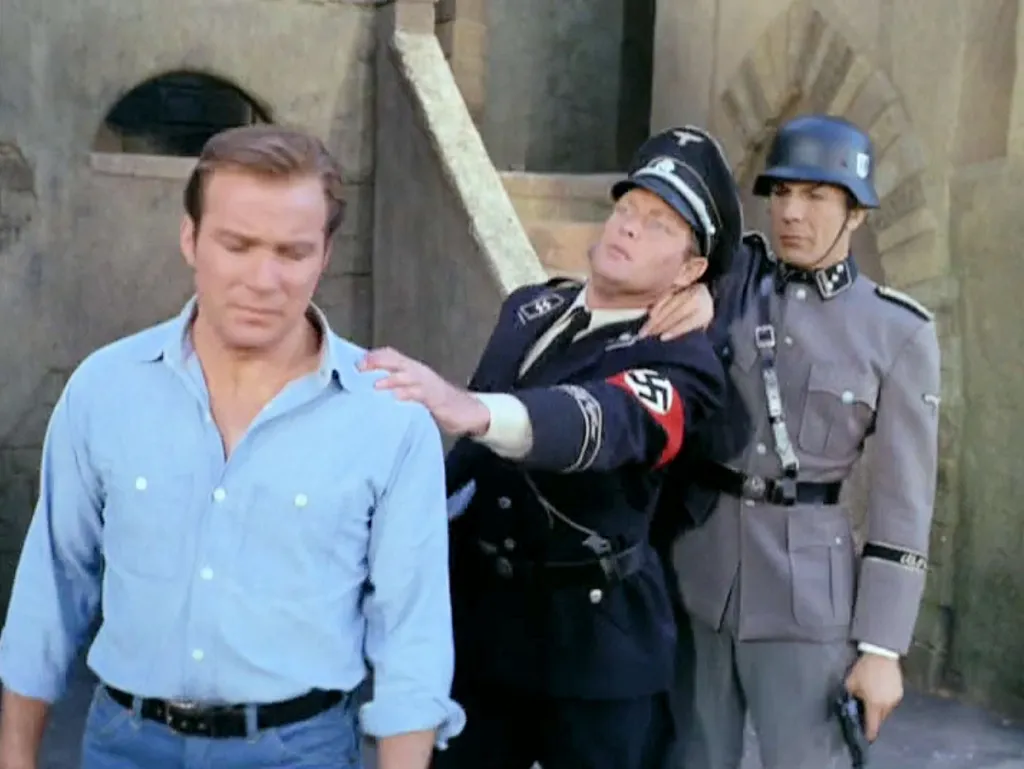
John Gill, like Roger Korby and Dr. Tristan Adams , is revered throughout the Federation but has gone completely off the rails by the time we meet him. Gill’s writings have been important to Spock’s knowledge of earth history, which explains a lot, and Gill was one of Kirk’s instructors at Starfleet Academy. “What impressed me most,” Spock says, “was his treatment of earth history as causes and motivations rather than dates and events.” Besides the fact that Vulcan history must be a result of causes and motivations as much as earth’s, it makes Gill’s transition from respected historian to fascist fundamentalist all the more bizarre. Or maybe the Gill/Korby/Adams pattern isn’t so surprising; maybe their substance never did live up to their image. An easy example from our own contemporary history is Harvey Weinstein , who founded a highly successful concert promotion business with his brother in 1972, only four years after “Patterns of Force” aired. Later, via Miramax (launched in 1979, the same year Star Trek: The Motion Picture was released) and The Weinstein Company , Weinstein helped give the world The Thin Blue Line (1988), The Crying Game (1992), Pulp Fiction (1994), Good Will Hunting (1997), and a long list of other films. He supported fundraising for poverty, AIDS, multiple sclerosis, and a host of other issues. At the same time, Weinstein was known in industry circles as “aggressive” to the point of violence, on top of the many sexual assaults he committed over the years. Maybe John Gill was a super-achiever like Weinstein, creating a bubble of respectability that hid his dark tendencies.
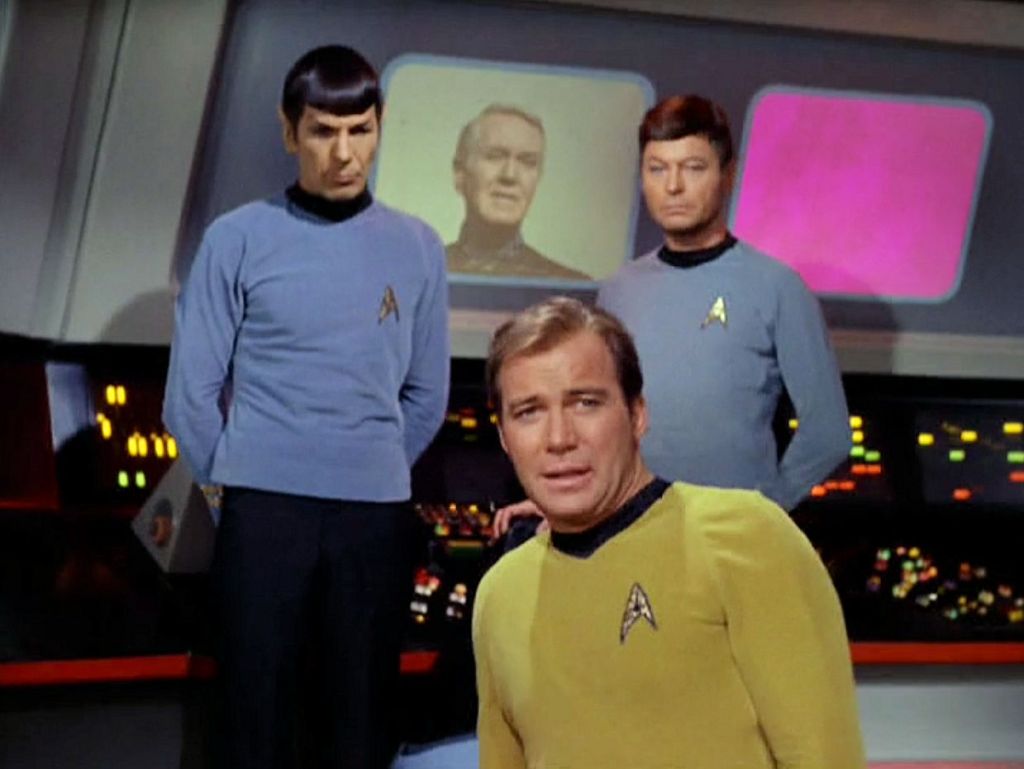
The timeline adds to the confusion of Gill’s behavior. We’re told that Ekos’ Nazi movement began only a few years ago and coincides with Gill’s arrival. Yet Daras ( Valora Noland ), the Ekosian resistance member posing as a highly-decorated Party officer, says she grew up admiring Gill; Valora Noland was twenty-six years old when “Patterns of Force” aired. Ekosians’ technology is “generations” ahead of where it’s expected to be, and it’s remarkably similar to earth technology of the 1940s. Even if Gill was here for twenty years, how did he accomplish so much change? The logical comparison is Hitler, whose Beer Hall Putsch took place in 1923. While Hitler drove Germany to fearsome achievements, he also committed gross errors (more on that later), and twenty-two years later he was dead and Germany was in ruins. This dramatic transformation, however, was primed by the First World War and the subsequent economic downturn that invited the likes of Hitler to power in the first place. Regardless of how much time it really took Gill to ruin not one, but two planets, he has only been out of contact with the Federation for six months. Someone in the Federation hasn’t been observing the observer.
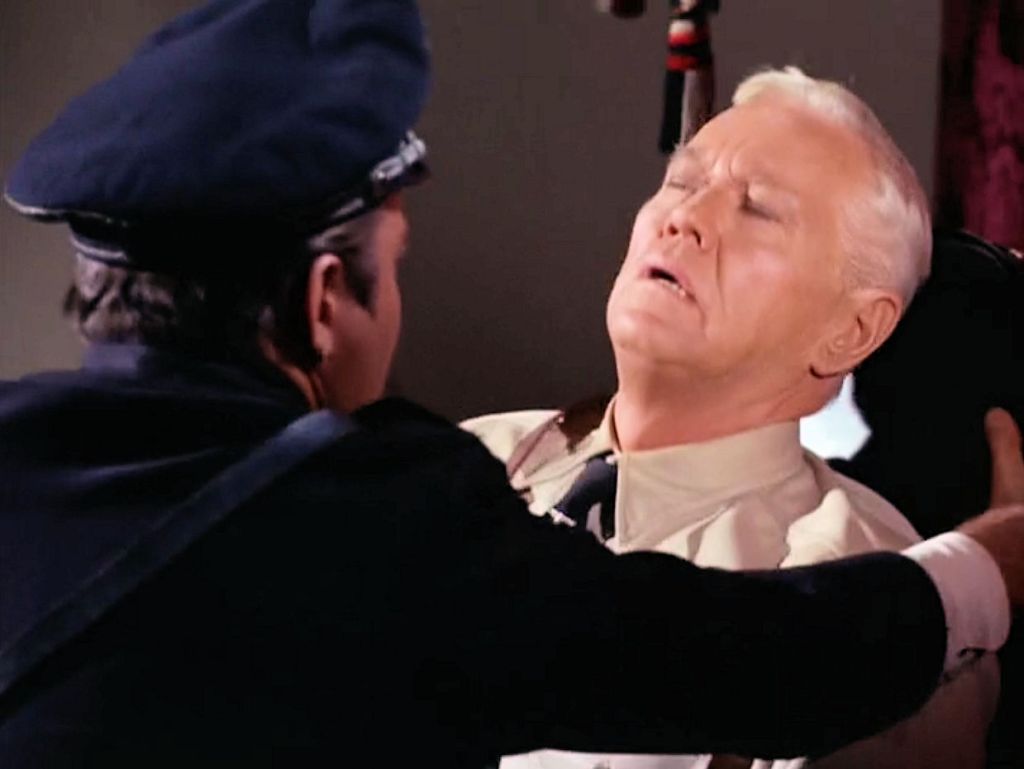
Some poor attempts at humor muddle the episode’s tone. Spock, charging into Nazi headquarters with Kirk, talks about the “exhilaration” of risk; ridiculous, considering Spock’s prior knowledge of probabilities and his ongoing mission of risk. McCoy struggles to put on stormtrooper boots – the uniform fits as poorly as the politics, wink, wink. Spock’s first appearance in a uniform seems intended to be funny – “That helmet covers a multitude of sins,” Kirk says – but it’s creepy instead. As Kirk puts on his own stolen uniform, Spock tells the captain, “You should make a very convincing Nazi.” The episode ends, as the series too often did, with a light-hearted exchange between Kirk, Spock, and McCoy. Perhaps NBC was trying to capitalize on the success of Hogan’s Heroes , which ran on CBS from 1965 to 1971 and was nominated for twelve Emmy Awards. Hogan’s Heroes , which some suspected was inspired by the 1953 film Stalag 17 , depicted the lives of Allied prisoners in a German World War II prisoner-of-war camp. The prisoners were comfortable and never in any real danger, while the Nazis were dim-witted but likable oafs too soft-hearted to cause serious harm to anyone. Whatever the objective, the attempts at humor in “Patterns of Force” fall flat and diminish the episode’s serious moments.
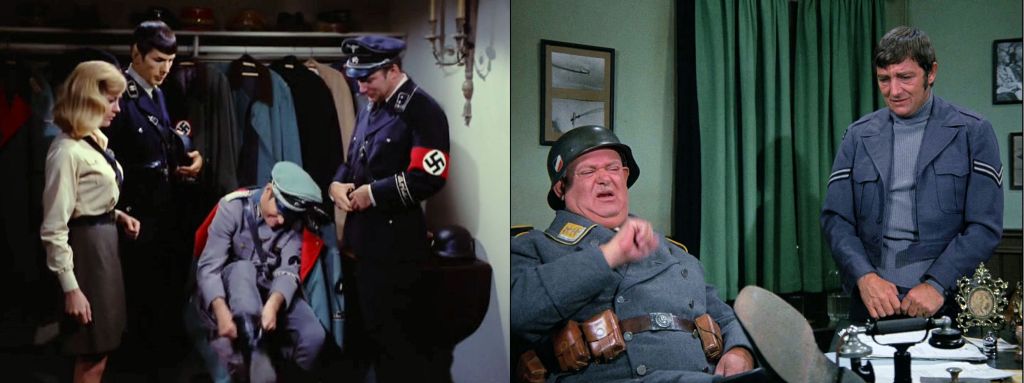
Even when it tries to be serious, “Patterns of Force” feels, well, forced. As always, our 23 rd century crew has detailed knowledge of 1940s earth, which Ekos has been kind enough to copy. Spock says that because Ekosians are humanoid “there is apt to be a similarity of architecture,” which explains why the Ekosian city looks like 1930s New York City in “ The City On the Edge of Forever ,” which itself looked a lot like a Paramount Pictures back lot. Kirk and Spock are whipped by Nazis attempting to learn their sinister plan; Spock might have a high tolerance for pain, but even Kirk never really looks frightened or in pain. Before beaming down in search of Gill, McCoy outfits Kirk and Spock with “subcutaneous emergency transponders,” below-the-skin devices that provide a transporter lock if their communicators fail. These handy devices foreshadow the combadges in use by the time of TNG and also they sure would have been helpful in every episode before this . Worse, when Kirk and Spock are locked in a prison cell flimsy enough for Otis from Mayberry to escape from, they MacGyver the transponders into a laser-cutting device and burn the lock on their cell door. (While all of this happens, the two men are without their shirts for an uncomfortable length of time.) Spock’s powers have also grown exponentially, so he not only mind-melds with Gill but renders Gill unable to initiate speech while still able to answer questions. Finally, as if the Ekosians-as-Nazis and Zeons-as-Jews analogy wasn’t already obvious (Zeon = Zion , get it?), the resistance members who rescue Kirk and Spock are Davod ( Chuck Courtney ), Isak ( Richard Evans ), and Abrom ( William Wintersole ). Oy vey!
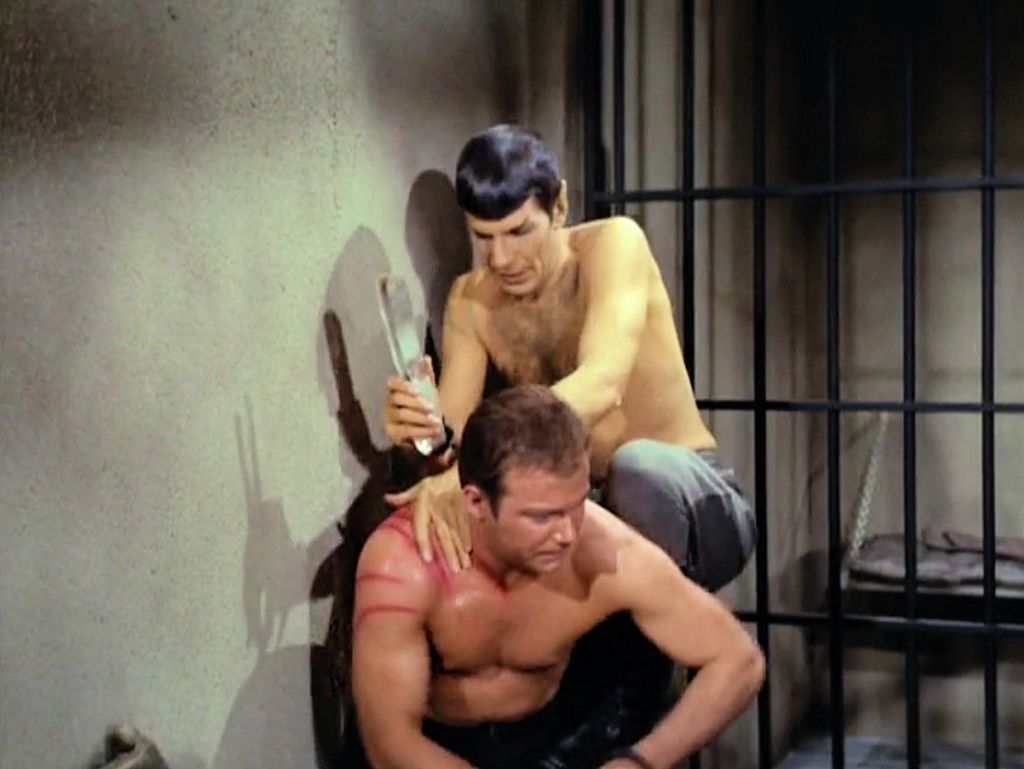
Some of the dramatic moments do work, but they deserved a better episode. During the prologue, Spock describes the two planets: “The Ekosians are a primitive, warlike people in a state of anarchy. The other planet, Zeon, has a relatively high technology and its people are peaceful.” Just as overpowering their enemies with advanced technology was part of the real Nazis’ strategy, so Ekos has now developed nuclear missiles with which to threaten Zeon. But this all came about because of the generosity (or hubris?) of the Zeons, sharing a foundation of scientific knowledge for the Ekosians to build on: “We thought we were civilizing the Ekosians,” Isak says when explaining early interactions between the two planets. It’s significant that Ekosians and Zeons are working together in the resistance, because they will need to rebuild both worlds together if they defeat the Nazis.
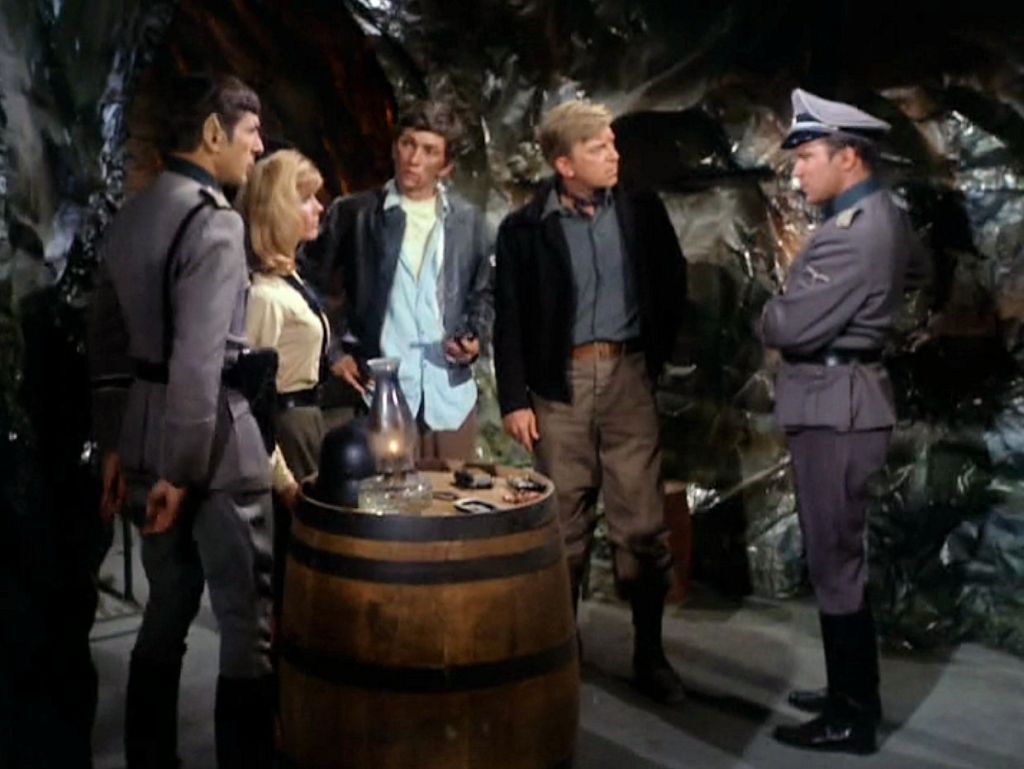
“Patterns of Force” also demonstrates the importance of propaganda to fundamentalist movements: every action must be a success, even when it isn’t. An Ekosian missile attack on the Enterprise is easily thwarted, but Ekosian television (Hey! They have TV, just like us!) broadcasts news of their great victory against a hostile invader. The real Nazis, even when they were clearly losing the war militarily, claimed one triumph after another as long as they could sustain the illusion. Ekosians consistently refer to Zeons as “pigs” but the real Nazis described Jews as child-abductors and Allied soldiers as cowards and criminals. Finally, the episode identifies the necessity of an enemy, an other, as a beacon to nationalism: when asked why the Nazis hate Zeons, Isak says, “Because without us to hate, there would be nothing to hold them together.” Imagine how quickly the modern-day Republican Party would collapse without its irrational fear of immigrants or transgender individuals.
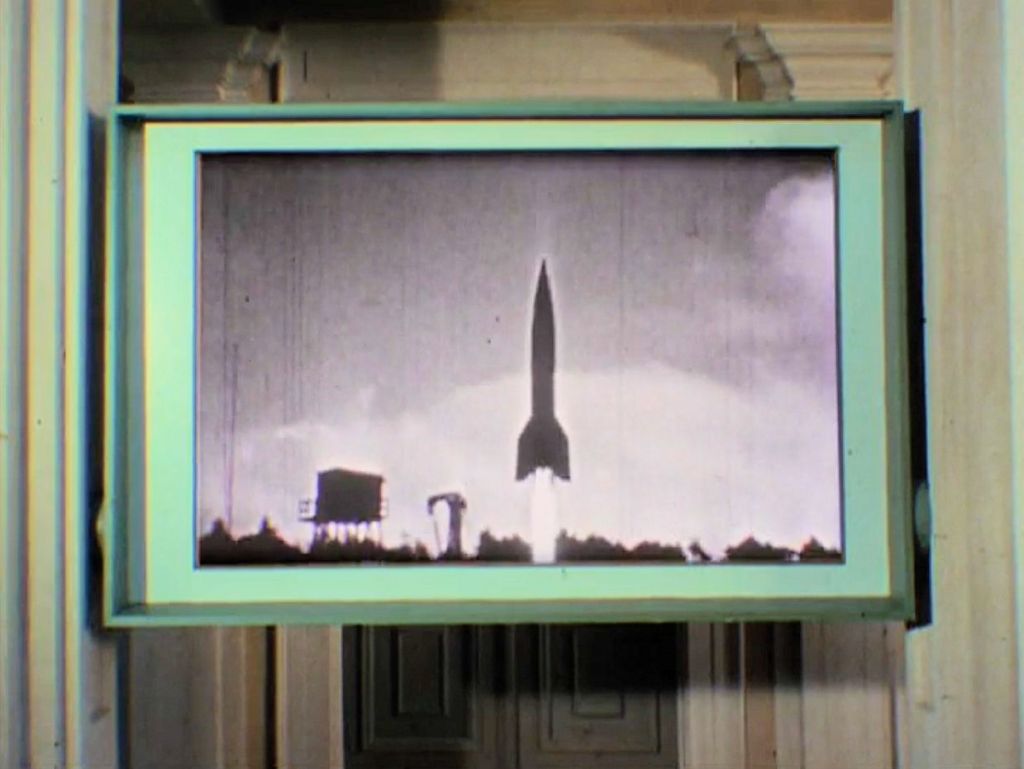
Perhaps the greatest strength of “Patterns of Force” is that it holds humans accountable. Unlike “ Wolf in the Fold ,” where evil is a shapeless force beyond our control, the villains here are easy to identify: John Gill and Melakon ( Skip Homeier ), the Ekosian who pushes Gill’s already twisted vision to its inevitable conclusion. Melakon drugs Gill and masterminds the Final Decision in a bare-faced power grab. “We were betrayed,” Gill says of Melakon, “by a self-seeking adventurer who has led us all to the very brink of disaster.” When a nearly comatose Gill delivers his penultimate speech, it’s hard not to think of a certain Very Stable Genius: “The speech follows no logical pattern,” Spock says, and Kirk calls it, “Random sentences strung together.” Gill’s sins are hubris and a failure to heed the lessons of his own profession. “Even historians fail to learn from history,” Gill says. “They repeat the same mistakes.” Gill claims he interfered in the first place because Ekos was “divided” and “fragmented,” without justifying why that required intervention. He goes so far as to call the Third Reich the “most efficient state earth ever knew,” and Spock agrees with him! The myth of Nazi efficiency was still widely believed in the 1960s, and many still believe it today. In fact, Germany under the Nazis created a false reduction in unemployment by removing women from the workforce while simultaneously importing twelve million factory and farm workers from other countries as forced labor. Wartime Germany generated funds partly through theft of assets from Jewish citizens and similar theft from countries it occupied. Militarily, the country became too extended to support itself, caused in part by the disastrous invasion of the Soviet Union in the winter of 1941. If Nazi Germany had been as efficient as some people claim, they would probably have won the war. And how could John Gill, a student of history, ever have believed that the Nazis were superior to the post-racial, post-capitalist, post-everything-bad Federation of the 23 rd century?
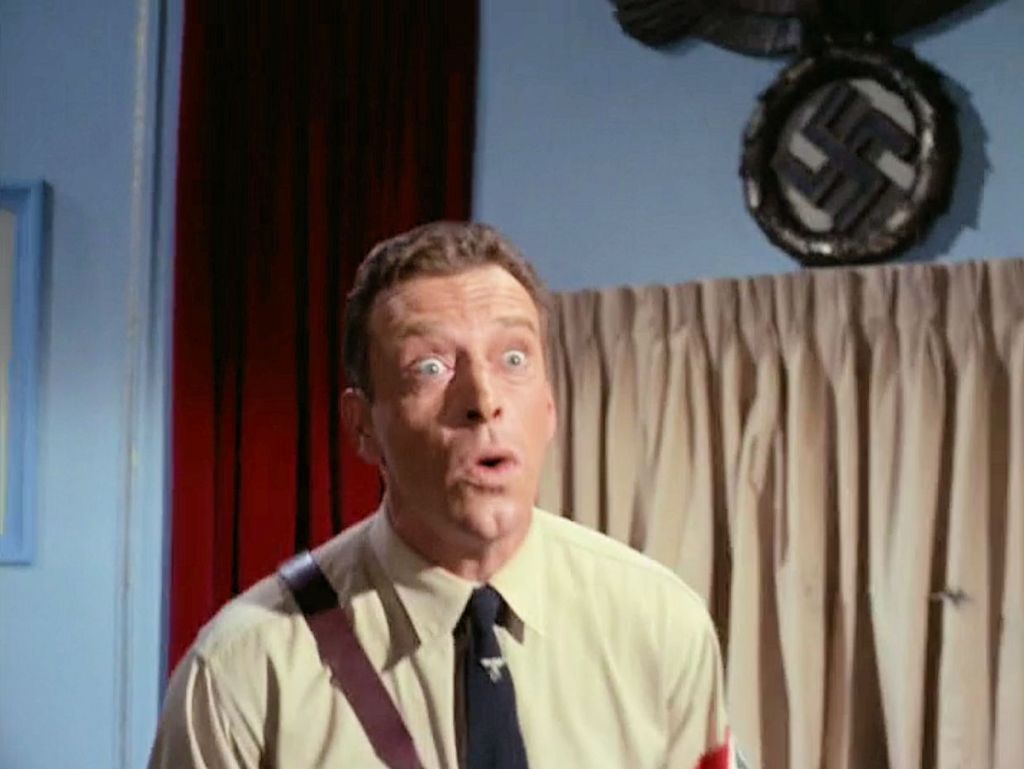
Sometimes a lack of subtlety works – I consider the very un-subtle season three episode “ Let That Be Your Last Battlefield ” one of TOS’ finest moments – but “Patterns of Force” is essentially a clumsy time travel episode wielding deadly serious subjects. Both Leonard Nimoy and William Shatner were Jewish; I haven’t found any statements about how they felt about the episode, but Leonard Nimoy chose not to participate in on-set promotional photographs wearing a Nazi uniform, for fear it would reflect poorly on his participation in a children’s Hanukkah service that same year. (“Patterns of Force” was filmed in late November and early December, 1967.) At least we can take a lesson from the episode, the lesson that John Gill and so many real humans have never mastered. McCoy spells it out for us in the final scene: “A man who holds that much power, even with the best intentions, just can’t resist the urge to play god.” Just to be sure we get it, he swings the hammer again: “Absolute power corrupts absolutely.”
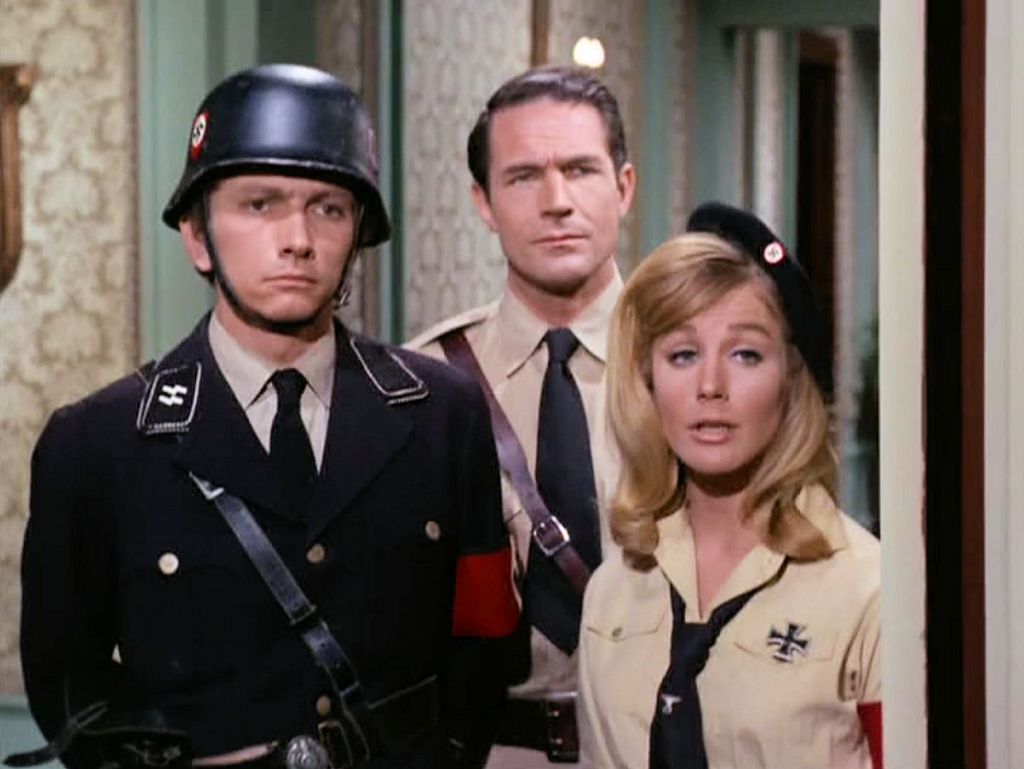
Come to think of it, maybe we have mastered the lesson. Maybe the problem is that too many humans accept absolute corruption. Spock seems to confirm that this has always been the case, when he says, “Your whole earth history is made up of men seeking absolute power.” In the case of Ekos and Zeon, John Gill understands in his final moments that the Prime Directive is ultimately about restraint of power: “The noninterference directive is the only way.” And unlike other planets that Kirk has left in ruins after collapsing their way of life – “ The Return of the Archons ” and “ The Apple ” come to mind – Zeon and Ekos seem better prepared to move forward together, with serious people ready to take the lead in uniting the two worlds. Spock even invites comparison to the reunification of East and West Germany , something that didn’t take place until 1990, when he says, “With the union of two cultures, this system would make a fine addition to the Federation.” If that sounds a little ominous, like a colonizer with an eye on future spoils, at least the Zeons and Ekosians have a confidence those previous societies lacked. Instead of being left behind, this time they tell the imperialists to leave.
Next: By Any Other Name
Share this:

- Already have a WordPress.com account? Log in now.
- Subscribe Subscribed
- Copy shortlink
- Report this content
- View post in Reader
- Manage subscriptions
- Collapse this bar
An archive of Star Trek News
Patterns of Force
You may have missed.

Several S&S Trek Books On Sale For $1 This Month

- Star Trek: Lower Decks
Another Classic Trek Actor On Lower Decks This Week

Classic Trek Games Now On GOG

- Star Trek: Prodigy
Star Trek: Prodigy Opening Credits Released
- Buy the Book…
- Reviews Hub

the m0vie blog

Following Us
- Adding Our RSS Feed to Your Gmail
- Following our Feed in Internet Explorer
- Millennium (Reviews)
- Star Trek: Deep Space Nine (Reviews)
- Star Trek: Enterprise (Reviews)
- Star Trek: The Next Generation (Reviews)
- Star Trek: The Original Series (Reviews)
- Star Trek: Voyager (Reviews)
- The X-Files (Reviews)
- X-Files Fandom Poll Form
Check out the Archives

Awards & Nominations

Star Trek – Patterns of Force (Review)
The first Star Trek pilot, The Cage , was produced in 1964. To celebrate its fiftieth anniversary, this December we are reviewing the second season of the original Star Trek show. You can check out our first season reviews here . Check back daily for the latest review.
Patterns of Force is a rather strange little episode, the type of weird and iconic adventure that Star Trek tended to do quite well. It’s very much an off-the-wall adventure, of the kind that none of the spin-off shows would attempt. “Planet of the Nazis” is a concept that belongs alongside other second-season episodes like “Planet of the Romans” or “Planet of the Gangsters.” It’s a very goofy premise, one that requires considerable suspension of disbelief before the episode even starts.
And, yet, despite the many serious problems with Patterns of Force , this is an episode that very clearly and very forcefully has something to say. Reflecting the world in which it aired, Star Trek is a show that is largely defined by the Second World War. In The City on the Edge of Forever , it was revealed that the Second World War had to happen to beckon the bright and optimistic future of Star Trek . Almost forty years later, the final televised season of the franchise would return to that idea in its opening episode.
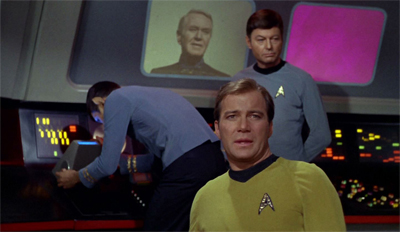
“Computer, query. What is Godwin’s Law?”
Kirk’s “final frontier” was Kennedy’s “new frontier” extrapolated centuries into the future, an optimistic and very American vision of what the twenty-third century might hold. Given that the show aired two decades following the end of the Second World War, the conflict that made America the most powerful global superpower, it makes sense that the conflict should cast a shadow over Star Trek . Various members of the production had served in the conflict, and it remained part of the national consciousness.
So an episode pitting Kirk and Spock against honest-to-goodness space Nazis seemed inevitable.
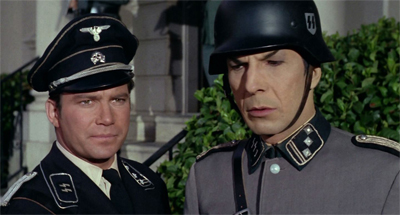
“Well, there goes syndication in Germany…”
Of course, there are very serious flaws with the script for Patterns of Force , even before we consider the Naxi iconography and imagery. The script is not subtle. The persecuted minority literally come from the planet “Zeon.” The Zeon characters all have names derived from Judaism. Isak is obviously Isaac, while Abrom is an abbreviated Abraham. Not only have the people of Ekos constructed a perfect mirror of Nazi Germany, they have also found the perfect people to persecute.
There’s also a sense that script for Patterns of Force has been heavily padded out. Over the course of Patterns of Force , Kirk and Spock wear three different sets of Nazi uniforms, implying a sequence of familiar captures and escapes that echo the padding in By Any Other Name . Even Kirk seems a little frustrated by how often they are repeating the same beats. “Get into the uniform and hide those ears again,” he instructs Spock.

“This is a nice cap. I feel like I need two more to complete the set.”
Patterns of Force spends considerable time stalling, trying to keep Kirk and Spock away from Gill until the final act. So they are captured and they escape, and they join the underground resistance. Once they arrive at the lair of the underground resistance, they are caught up in a fake sting operation to test their loyalty. The sequence also (conveniently) provides a nice suspenseful act break without requiring any real stakes. It’s a painfully contrived sequence.
This is to say nothing of the ending, which seems to imply that all of the damage that Gill has done to the people of Ekos and the relationship between Zeon and Ekos can be conveniently reversed with a single heart-felt speech. Sure, Melakon is dead, ending his reign of terror. However, one of the core themes of Patterns of Force is that systems like the system on Ekos tend to support brutal dictators and are prone to exploitation.
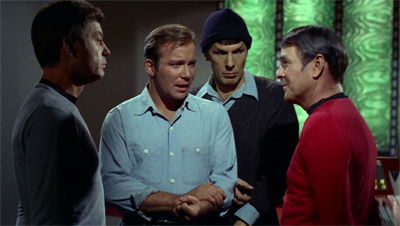
“At least the wardrobe tips we picked up in The City on the Edge of Forever are useful…”
As such, it seems a bit feckless for the Enterprise to just fly off back to the stars after the death of the two most prominent members of the regime and to assume that that Nazi party can dismantle itself cleanly and efficiently. Eneg and Daras might hope to fix the damage themselves, but this is not something that goes away. After all, the publication and subsequent banning of the infamous “Brown Book” in West Germany during the mid-to-late sixties demonstrated that those wounds were still open.
Of course, the Federation doesn’t really have any moral authority when it comes to helping Ekos recover – this was damage inflicted by a Federation observer. At the same time, it seems weird that Kirk makes no offer of assistance or that the Federation does not offer to send support to help repair some of the damage done to Ekos and Zeon by Gill. The script for Patterns of Force has a lot of fundamental story problems, in terms of basic structure and providing a satisfactory ending.

If only the script were this focused…
And yet, despite all that, Patterns of Force has some interesting things to say. The episode just makes it quite difficult to see what exactly those things are. It is very tough to see past the Nazi iconography, after all. The show’s version of history is… clumsy, at best. In You’re Doing It Wrong , Michael Lewis observes:
Unlike A Piece of the Action and City on the Edge of Forever, which we might dismiss as being historically unlikely, it’s more than a little tempting to treat Patterns of Force as something that comes closer to the historical truth about Nazi Germany, since historians generally agree that Adolf Hitler’s personal magnetism and powerful speaking skills were important factors in the Nazis’ rise to power. Where Star Trek’s writers get it wrong in this episode is their stress on a powerful leader being the only cause of Nazism and the Holocaust: the historical record clearly demonstrates the importance of other factors as well.
However, in defense of Patterns of Force , the episode seems to realise this. Gill is regarded as a great historian, with Spock praising his “treatment of Earth history as causes and motivations rather than dates and events.” However, it would seem impossible to divorce the two.
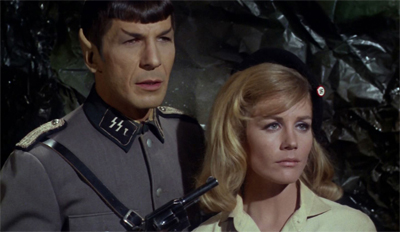
“Ain’t no party like a Nazi Party…”
“Causes and motivations” are very good for sketching out the psychology of history – for understanding why and how a particular society could make the decisions that they make at that particular time. However, it is impossible to boil history down to something as simple as “causes and motivations” , if only because society is not a single homogenous entity. Different sections of society – and subsections within those sections – all have their own complex “causes and motivations.”
“Dates and events” are important because they provide a sense of context for history – there are any number of complex factors, not always directly related to one another, that serve to push a particular society down a particular path. Spock’s observation about Gill’s approach to history seems to suggest that Patterns of Force isn’t really about history. Based on what we learn of Gill here, he seems more like a sociologist than a true historian.
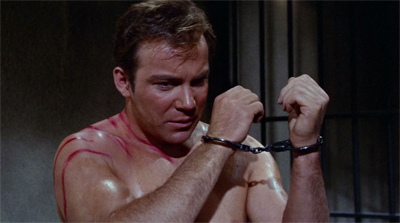
The chains of history…
Patterns of Force is aware of its own absurdity and nonsensical elements. Landing on a set on the studio backlot, Spock tries to explain why it looks so familiar. “The Ekosians are humanoid, so there is apt to be a similarity in architecture,” he suggests – which doesn’t really explain too much. After all, there is a radical divergence in architectural styles across the planet Earth, to say nothing of the unconventional architecture we’ve seen on worlds like Vulcan.
Similarly, Kirk points out how eerily perfect the Nazi cosplay happens to be. “The chances of another planet developing a culture like Nazi Germany, using the forms, the symbols, the uniforms of twentieth century Earth are so fantastically slim,” he observes. Spock agrees, “Virtually impossible, Captain, yet the evidence is quite clear.” Although there is a reason for this, it invites the audience to wonder why Gill didn’t change the iconography slightly, or tweak the imagery, or why the people of Ekos didn’t have their own spin on some of the visuals.
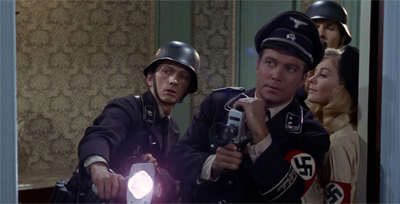
“Work the camera…”
However, this seems to get to the point of Patterns of Force . Despite the emphasis on Gill’s role as a historian, Patterns of Force isn’t actually about history. This is why we can forgive the rather clumsily historical errors here, like Gill’s suggestion that Nazi Germany was “most efficient state Earth ever knew.” As Bodie A. Ashton points out, this is a historical fallacy :
It was in this context that Hitler would eventually rise to power and, certainly, the logic of the conclusions drawn (as much by the fictitious John Gill as by real, established names in the field) seems impressive. In 1933, on the eve of Hitler’s rise to power, official unemployment stood at six million. Within a year it had been halved, and by 1937 fewer than one million Germans were without jobs. In order to raise the employment figures, the regime had begun a number of public works schemes, including the famed Autobahn motorways. Several thousand kilometres of road were built in a few short years, and the Autobahnen alone had employed over 150,000 Germans in gainful work. The number of welfare recipients soon fell by more than 60 percent in large cities. Indeed, by 1936, Germany was in such a strong economic position that Berlin was able to host a triumphant Olympic Games, complete with all the pageantry expected of the situation, and German Zeppelin airships criss-crossed the Atlantic as symbols of renewed German might. The design of the so-called “People’s Car” (Volkswagen), which would open motoring to the masses, was another crowning achievement of the regime’s economic policies. Away from industry, too, the economy had improved. Agricultural production gained from strength to strength throughout the 1930s, and by 1939 output was some 71 percent higher than it had been in 1933 – no doubt an amazing achievement. In short, Germany’s economic recovery, it is claimed, was a miracle, a Wirtschaftswunder before the term had been coined, and at the heart of this were Hitler and his ministers. This logic is seductive, but it is based on faulty assumptions. Let us first address the question of the motorways. The Autobahn project certainly employed over 100,000 people, and the country was soon festooned with bitumen and bridges. These projects, however, were not entirely of the Nazis’ making. The first Autobahn – Hamburg to Basel – was begun in September 1933, but it had been in the works for years; only the more pressing matters of combatting the hyperinflation of the early 1920s had prevented the successive Weimar governments from implementing the plans. It is also worth noting that, though it was begun in 1933, the Hamburg-Basel corridor was not completed by the time construction work was suspended due to the outbreak of war in 1939. It would not be finished until the 1960s. In any event, while the Autobahnen were successful insofar that they were built, and that they employed more than 100,000 otherwise unemployed Germans, the plan had been for the projects to employ over four times as many people as they actually did. On their own terms, then, the Autobahn projects were, at best, only qualified successes. But even if the motorways were built, they were useless without traffic. Here we have an illustration of the strange nature of Nazi economics, or the difference between image and reality. In 1939, the prototype of the Volkswagen was demonstrated by Hitler himself in Berlin, but the car did not enter production at all under the Third Reich, in spite of the Führer’s pledge to have a million of them built every year. Without this “People’s Car”, the Reich had begun building a system of roads that were inaccessible to most Germans, since motoring was an unaffordable luxury. At the height of the Autobahn building phase, in 1935, for every sixty people in Germany there was just one automobile, compared to one for every twenty in France, or one for every twenty-five in Denmark; in the United States, one person out of every five owned a car of their own.
To be entirely fair, this view was commonly held into the sixties, even if it has since been revised and reassessed. It turns out that Gill is a pretty crappy historian – as if deciding to model an entire culture on Nazi Germany were not evidence enough of his questionable approach to his craft.
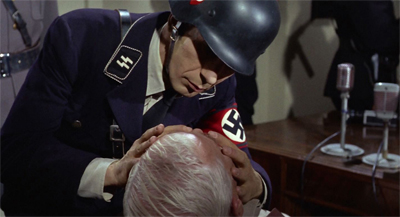
“Sadly, my patented Vulcan facial massage does not appear to be doing any good…”
It would be quite comforting to believe that the Nazis were an organisation of unparalleled efficiency. If the Nazis were that good at running a fascist state, the rest of the world could feel more at ease about their complacency. However, as Roderick Stackelberg observes in Routledge Companion to Nazi Germany , the Nazi ethos did not lend itself to efficient governance:
Certainly the Social Darweinist ethos of competition and struggle for power that pervaded the party promoted friction and jurisdictional distputes, often resulting in inefficiency, duplication of tasks, and conflicting priorities. The system offered plentiful opportunities for self-promotion in the name of the national interest. Nazi officials were often personally corrupt, using the powers of their offices for material gain. Hitler’s own unbureaucratic style of working, his aversion to official routine, and his indifference to detail added to the incoherence of the system.
So the entire historical premise of Patterns of Force is completely baseless. Nazi Germany was not an efficient state. However, Patterns of Force is not a story about historical accuracy any more than The City on the Edge of Forever is, or A Piece of the Action . It is not even about our relationship to history in the same way that The City on the Edge of Forever could be said to be.

The Reich stuff…
Much like The City on the Edge of Forever is clearly informed by the public mood around the Vietnam War, Patterns of Force reflects contemporary politics and realities more than any accurate semblance of history. Like the other “alternate Earth” stories from the second season – Bread and Circuses and A Piece of the Action – this is allegory. It is heavy-handed allegory trading in iconography that exists within living memory for most contemporaneous viewers, but it is definitely allegory.
To be fair to Patterns of Force , while its portrayal of the Nazi regime is hardly nuanced or sophisticated, it is also not entirely cartoonish or superficial. Star Trek did not have the budget to depict concentration camps in 1968, and it seems unlikely NBC would have allowed it. However, there is a casual brutality to it all – Melakon’s casual explanation of Spock as inferior, the brutal beating of Isak in broad daylight, the scarring of Kirk and Spock under “interrogation.” In other words, this may not be Schindler’s List , but it is not Hogan’s Heroes either.
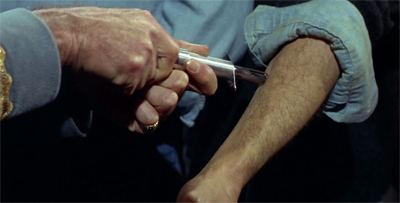
Injecting a little excitement…
Patterns of Force aired in February 1968. At that point, cultural attitudes about Nazi Germany were shifting. As Marc Hieronimus reflects in Hitler is Fun , pop culture’s depictions of Nazi Germany were a lot freer and looser than they had been before:
After a period of dark and grave representations, writers and film directors began to depict the mythical, apocalyptic, mundane, kitsch, or otherwise seductive elements of Nazism; the very amalgam of kitch and death so typical and peculiar for Nazi ideology, where discourses and representations of family luck and tradition went together with those of purity, health, power, and invincibility on the one hand and of downfall, ruin, and death on the other. The reproach against the generation of culprits whose acts were tried in the Auschwitz Trials and discussed broadly in public, a smoldering generational conflict, and the 1968 atmosphere of departure spurred filmmakers like Alexander Kluge, Hans Jurgen Syberberg, Helma Sanders-Brahms, and Rainer Werner Fassbinder to try new ways of dealing with the Nazi past.
Most obviously, Mel Brooks would release The Producers a month after Patterns of Force aired, demonstrating that there was more opportunity for storytellers to play with and explore the associated iconography than there had been before. (Brooks has conceded that the film’s treatment of Hitler generated some controversy at the time .)

“Vere is the grail?”
As Saul Friedlander noted in his Essay on Kitsch and Death , it was becoming a lot easier to talk about Nazi Germany in popular culture, with the late sixties opening up avenues of discourse and debate about that dark chapter in German history:
At the end of the war, Nazism was the damned part of Western civilization, the symbol of evil. Everything the Nazis had done was condemned, whatever they touched defiled; a seemingly indelible stain darkened the German past, while preceding centuries were scrutinized for the origins of this monstrous development. A sizable portion of the European elites, who two or three years before the German defeat had made no secret of their sympathy for the new order, were struck dumb and suffered total amnesia. Evidence of adherence, of enthusiasms shared, the written and oral record of four years of coexistence with it, and indeed of collaboration, often vanished. From one day to the next, the past was swept away, and it remained gone for the next twenty-five years. By the end of the Sixties, however, the Nazi image in the West had begun to change. Not radically or across the board, but here and there, and on the right as well as the left, perceptibly and revealingly enough to allow one to speak of the existence of a new kind of discourse.
It has been suggested that West German Chancellor Conrad Adenauer proscribed “the sleep cure” for his country , stiffling debate and discussion of Nazi Germany. Now that a generation had passed since the end of the conflict, such matters could be discussed.
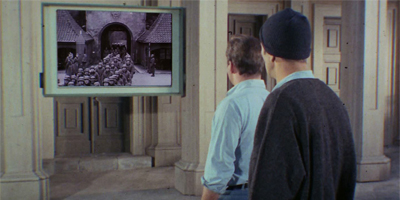
The march of history…
However, by the late sixties, it was not just possible to discuss this uncomfortable chapter of history, but necessary. The sixties had seen a surge in the neo-fascist movement, with a number of right-wing political organisations emerging across Europe. As Richard Griffiths notes in Fascism , these parties began to gain political ground:
Though, in the immediate post-war period, a number of small parties of the extreme Right grew up in most countries of Europe, they were remarkably unsuccessful, and attracted only an infinitesimally small portion of the population in each case. It was in the sixties that successful movements of the extreme Right began to emerge across Europe; and since that time there have been frequent Press ‘scares’ about the possible advent to power of such movements – a fear that recently became reality with the success of Jorg Haider’s Freedom Party in Austria.
It appears that Gill may not be the only person who has failed to learn from history. While nobody was quite establishing a facsimile Nazi state in 1968, there is a sense that Patterns of Force ‘s concerns are not completely unfounded.

Captivating television…
The fracturing of the Freedom Party of Austria in 1967 (with more right-wing elements founding the National Democratic Party) had served to make the organisation more palatable to the mainstream . That same year, Georgios Papadopoulos had established a military junta in Greece, with the support of America and and other democratic powers . The influence could even be felt in more established and stable democracies. In April 1968, Conservative MP Enoch Powell would deliver his infamous “rivers of blood” speech in Birmingham .
However, these shades of neo-fascism are not unique to the political right. In Liberal Fascism , author Jonah Goldberg argued that fascism not a political position that can be defined on the traditional left/right spectrum, but instead a philosophy of leadership that can take root within any ideology . It is, as Kirk describes it in Patterns of Force , “the leader principle.” It is the fantasy of the benign dictator – something that can appeal to liberals as much as conservatives . After all, even Kirk romanticised Khan in Space Seed .

It’ll do in a pinch…
It is clear that Gill is infatuated with the idea of a strong authoritarian government, one that can unite the people of Ekos and provide a clear sense of purpose. When Kirk wonders what might have motivated Gill, Spock replies, “Perhaps Gill felt that such a state, run benignly, could accomplish its efficiency without sadism.” Of course, Gill fails to understand that system is itself designed to encourage and enable sadism. People like Melakon will always thrive in a structure like this, regardless of best intentions or lofty goals.
Eulogising Gill, Kirk reflects, “He drew the wrong conclusion from history. The problem with the Nazis wasn’t simply that their leaders were evil, psychotic men. They were, but the main problem, I think, was the leader principle.” McCoyexplains it to the viewers at home too slow to follow along, “What he’s saying, Spock, is that a man who holds that much power, even with the best intentions, just can’t resist the urge to play God.” Spock, master of sarcasm, points out how heavy-handed that moral is. “Thank you, Doctor. I was able to gather the meaning.”
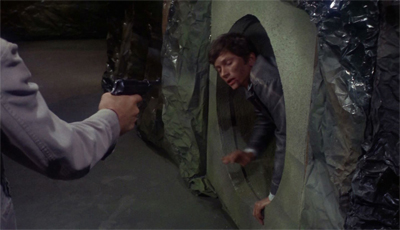
Tunnel vision…
To be fair, while this is all rather on the nose, it is a point worth repeating. It is tempting to write off the horrors of Nazi Germany as some sort of grotesque aberration – the result of the wrong people in the wrong place at the wrong time. Similar to the “it could never happen here” sentiment, this dismissive attitude glosses over the lessons that need to be learned about Nazi German. “Adolf Hitler was a terrible man” goes without saying, but “maybe we need to consider our relationship with authority structures” is a bit more nuanced.
All of this leads to possibly the shrewdest twist in Patterns of Force . Having beamed down to Ekos and infiltrated the Nazi Party, Kirk and Spock finally manage to confront John Gill. However, they discover that John Gill is not so much playing the role of Adolf Hitler as the Wizard of Oz. It’s a deliciously brilliant and ironic twist, not least because it predates Wicked by almost three decades. It’s almost enough to excuse the other faults with the clumsy script.

He’s certainly a whizz…
In some respects, Patterns of Force plays The Wizard of Oz as a fascist fairytale, something that Gregory Maguire would develop further when he wrote Wicked in the mid-nineties. Certainly, Patterns of Force invites the viewer to make the comparison, with Kirk and Spock (and the supporting characters they pick up along the way) all embarking on a quest to visit a wisened old man who might be able to explain this crazy world to them.
Gill is a man who fell from the sky and declared himself ruler of a strange civilisation. He delivers pronouncements to the populace via media technology while remaining hidden himself. Kirk is surprised that Gill does not make his big speeches in person. “They watch him on the big screen,” Daras explains. “He broadcasts from the booth for security.” Kirk notes, in another echo of The Wizard of Oz , “They’ve got the booth curtained off.” Pay no attention to the man behind the curtain.
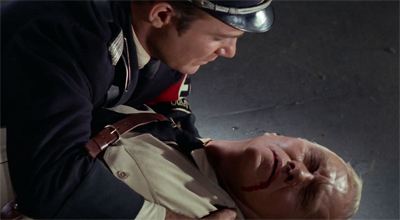
The historian is history…
As they sneak around inside the Nazi Party headquarters, Kirk and company are shocked to discover that Gill is not a wizard at all. He’s not even the Fuhrer. One could go a step further and suggest that Gill is as much a learned historian as Professor Marvel is a qualified professor. He is a huckster, a con man, a fraud. At the end of the episode, Kirk and his crew beam back to the Enterprise as eagerly as Dorothy and the Wizard return to Kansas, leaving this strange world in the care of a bunch of people they just met.
This wry subversion excuses the bluntness of the Nazi iconography – this is The Wizard of Oz but with swastikas, a striking juxtaposition. It suggests that the notion of the “benign dictator” is such a common concept that it barely registers unless its wearing a brown shirt and offering a Nazi salute. Patterns of Force is never subtle, but there are moments when it seems quite shrewd. It takes an impressive amount of self-confidence to cross a classic American fairytale with the Third Reich.

I love you even the cameras are branded, in case Kirk and company might be exposed by using a non-Nazi video camera…
Patterns of Force does benefit from a sense of humour about itself. It is never as glib as A Piece of the Action – after all, the subject matter is a bit heavier – but there’s a sense that Patterns of Force never takes its absurdity too seriously. Kirk and Spock get to trade affectionate barbs quite frequently and wryly, while McCoy beams down struggling to get into his Nazi uniform. At one point, Eneg and the guards catch our heroes locked together in a cupboard, which is a delightfully awkward moment for all involved.
Similarly, The episode also benefits from superb performances by the central ensemble. In particular, William Shatner is having a great deal of fun playing Kirk. The sequence where he and Spock arrange a jailbreak is played as light comedy amid everything else going on, providing perhaps the most Shatner-esque line reading in the show to date. “You realise that the aim will of course be very crude?” Spock confirms. Kirk, in agony, replies, “I! don’tcareif you hit the broad… side of a barn.”

“Captain, explain to me this concept of Naziploitation?”
It’s a thing of beauty, and movements like that prevent Patterns of Force ever seeming too stuffy or overwhelming. After all, this is an episode about Nazis… in space! As such, little bit of pulp and a little bit of camp never go entirely astray, even juxtaposed against the beating of Isak in the street or Melakon’s very casual brutality. Lightening the mood a little was a shrewd decision from the writing staff.
Even with this in mind, Patterns of Force doesn’t necessarily work as an episode of Star Trek , but does have a lot of clever and worthwhile things to say about authority and power. It’s a heavy-handed episode that occasionally threatens to bludgeon the audience into unconsciousness, but it also offers a clever commentary on contemporary politics and romantic fantasies. The result is often more itneresting than it is successful, but Patterns of Force is an episode that is too frequently and too easily overlooked in assessments of Star Trek .
You might be interested in our other reviews from the second season of the classic Star Trek :
- Supplemental: (Gold Key) #1 – The Planet of No Return!
- Supplemental: (Marvel Comics, 1980) #4-5 – The Haunting of Thallus!/The Haunting of the Enterprise!
- Metamorphosis
- Friday’s Child
- Who Mourns for Adonais?
- Supplemental: Spock’s World by Diane Duane
- Supplemental: New Visions #3 – Cry Vengeance
- Wolf in the Fold
- The Changeling
- Supplemental: (DC Comics, 1984) #43-45 – The Return of the Serpent!
- Supplemental: (IDW, 2009) #13 – The Red Shirt’s Tale
- Supplemental: Deep Space Nine – Crossover
- Supplemental: New Visions #1 – The Mirror, Cracked
- Supplemental: (DC Comics, 1984) #9-16 – New Frontiers (The Mirror Universe Saga)
- Supplemental: Mirror Images
- Supplemental: Mirror Universe – The Sorrows of Empire by David Mack
- Supplemental: (IDW, 2009) #15-16 – Mirrored
- The Deadly Years
- Supplemental: (Gold Key) #61 – Operation Con Game
- Supplemental: (DC Comics, 1984) #39-40 – The Return of Mudd
- Supplemental: The Galactic Whirlpool by David Gerrold
- Supplemental: Alien Spotlight – Tribbles
- Bread and Circuses
- Journey to Babel
- A Private Little War
- The Gamesters of Triskelion
- The Immunity Syndrome
- A Piece of the Action
- By Any Other Name
- Return to Tomorrow
- Patterns of Force
- The Ultimate Computer
- The Omega Glory
- Supplemental: Assignment: Eternity by Greg Cox
- Supplemental: (DC Comics, 1989) #49-50 – The Peacekeepers
- Supplemental: (IDW, 2008) Assignment: Earth
Share this:
Filed under: The Original Series | Tagged: benevolent dictator , benign dictator , denazification , efficiency , ekos , fascism , historian , history , isak , john meredyth lucas , kirk , nazis , neo-fascism , sixties , spock , star trek , Television , zeon , Zion |
8 Responses
Thank you for posting a link to The Myth of Nazi “Efficiency” by Bodie A. Ashton. I found it to be fascinating reading.
In any case, excellent analysis of “Patterns of Force.” I had never thought to draw parallels to The Wizard of Oz, but it is an insightful observation.
“It suggests that the notion of the “benign dictator” is such a common concept that it barely registers unless its wearing a brown shirt and offering a Nazi salute.” Very well said. I immediately recalled some of the admiration by American political pundits in the recent past for Vladimir Putin. The images of the autocratic Russian President confidently astride a horse, bare-chested, seemed to almost mesmerize some of these American commentators. The implication seemed to be “Why can’t WE have a manly, strong, decisive leader like that, instead of someone like Obama, who overthinks things and wants to be diplomatic and who always seems to be wavering?” Never mind that Putin is a brutal authoritarian who has suppressed free speech, persecuted homosexuals, invaded the Ukraine, and his policies have now resulted in the Russian economy going into free-fall. Some people would just rather have a ruler who is powerful and commanding and makes a country appear strong than a true representative of the people who considers all sides of the issues and attempts to govern in a fair manner.
I was quite proud of spotting The Wizard of Oz thing! I was joking at first, but was surprised how well it ended up sticking.
The benign dictator is a surprisingly common fantasy, on both sides of the spectrum, and in just about every Western context. The British House of Cards actually captures the sense of that appeal perfectly.
Oh, I agree, it is a common fantasy on BOTH sides of the political divide. At the risk of a generalization, comic book creators and readers are, on the whole, more liberal than conservative. So it interesting how many writers and fans seem to bend over backwards to try to paint Doctor Doom (from the pages of Fantastic Four and various other Marvel titles), the iron-fisted monarch of Latveria, as a well-intentioned extremist whose flaws unfortunately keep him from truly benefitting the world. There have even been readers who have screamed bloody murder when someone writes Doom committing some horrible act, arguing that he is supposed to be an “honorable” figure. The fact is, Doom is a monster with a monumental ego who wants to totally wipe out free will. In his own mind he sees himself as a noble, heroic figure. But the reality is that he is a ruthless tyrant whose supposed benevolence will take a back seat the instant someone defies him.
On my own blog, I have likened Doctor Doom to Khan Noonien Singh. They are similar characters. Just as Khan’s charm & charisma initially blinded Kirk to his true, dangerous nature, the same applies to Doom, who has a talent for putting his best face forward, causing both fictional characters and real-life readers to express misplaced admiration for him.
That’s a great point.
I’m a huge fan of Mark Waid’s take on Doctor Doom, which seems to have surprised a lot of fans. To paraphrase Waid, if Doom thought that slaughtering a baby would somehow prove he was better than Reed Richards, he would do it. (I can’t help but suspect that Byrne’s more sympathetic take on Doom is largely responsible for that dissonance.)
I also like Nolan and Morrison’s take on Talia Al Ghul, suggesting that she’s not simply a patsy for her father, but a character with her own agency and her own accountability for her decisions.
Interesting analysis.
One thing I’ve always wondered about — both Shatner and Nimoy are Jewish. What must it have been like for them to run around wearing Nazi uniforms for so much of this episode? Did the writers even consider what they were asking these guys to do?
I wonder that myself. That said, must of the writing staff – I know Roddenberry and Coon for sure, not sure about Lucas – served in the Second World War. I certainly suspect they would not have been entire cavalier about using Nazis themselves. But it’s obviously a completely different level of concern for Shatner and Nimoy. So I have no idea, but I wouldn’t be surprised either way.
This Tv Tropes page sums up it up well: “Sure, they might be brutal and genocidal, but at least they can make trains run on time and all that good stuff… only, the actual Nazis couldn’t even do that. With military resources spread across four completely separate services that had to be actively bullied by Hitler into cooperating (Heer, Kriegsmarine, Luftwaffe, SS)note , four economic institutions which competed for limited resourcesnote , two General Headquarters note , two intelligence services (Abwehr, SD) that never shared information and occasionally offed each other’s agents, two civil services and two courts (one regular/normal, one SS), and five atomic bomb programs that shared no information or resources with each other Nazi Germany was actually one of the most inefficient states in history – and that’s not even accounting for the gross corruption. In Real Life, the only thing efficient about dictatorships is their total control of the media, which they use to portray themselves as being extremely efficient (and benevolent) despite their crippling factional in-fighting and endemic corruption.”
http://tvtropes.org/pmwiki/pmwiki.php/Main/FascistButInefficient
“It suggests that the notion of the “benign dictator” is such a common concept that it barely registers unless its wearing a brown shirt and offering a Nazi salute.”
Sad to say, this statement is a little naive, with the dramatic rise in hate crimes in America, and the alt-right movement giving Trump the Nazi salute, Trump many supporters have little else to say but “Stop crying racist.” or “We’re not all racist”. Rather then putting a stop to this new rise in Fascism, it’s just uncomfortably accepted, because Trump will bring jobs, and that will apparently solve everyone’s problems.
Yeah. It’s an episode that certainly seems more pointed and relevant in this day and age. Nowadays, we don’t even recognise it when there’s leaked footage of it giving a Nazi salute.
Leave a comment Cancel reply
This site uses Akismet to reduce spam. Learn how your comment data is processed .
Recent Posts
- 371. Poor Things (#246)
- 370. Dune: Part Two (#12)
- 369. Memento (#57)
- 368. Monty Python and the Holy Grail (#154)
- 367. Star Trek: Generations (#—)
Recently tweeted…
- "I Simply Am Not There": The Existential Horror of Eighties Excess in "American Psycho"...
- Star Trek: The Original Series (Reviews)
- Star Trek: Voyager (Reviews)
- Adding Our RSS Feed to Your Gmail
- Star Trek: Enterprise (Reviews)
Available at…

Blogs Well Worth Your Time
- 1001 Must See Films
- Andrew at the Movies
- Anomalous Material
- Cut the Crap Movie Reviews
- Encore Entertainment
- Fandango Groovers
- FlixChatter
- Four of Them
- It Rains… You get Wet…
- Jameson Cult Film Blog
- Jar Watches Films
- Let's Go To The Movies
- M. Carter at the Movies
- Marshall and the Movies
- Movie News First
- Musings from a Man Lost in La Mancha
- Never Mind Pop Film
- Paragraph Film Reviews
- Roger Ebert's Journal
- Ross v. Ross
- Scannain.com
- Screenwriter (Donald Clarke, Irish Times)
- Strange Culture
- The Film Cynics
- The Pompous Film Snob
- The Projection Booth
- Things That Don't Suck
- Too Busy Thinking About My Comics
- Undy a Hundy
Film Nerd Resources
- CinemaBlend (News)
- Internet Movie Database
- Rope of Silicon
- The Guardian Film Blog
- James Berardinelli
- Roger Ebert
Email Subscription
Enter your email address to follow this blog and receive notifications of new posts by email.
Email Address:
Sign me up!
Blog at WordPress.com. WP Designer.
- Already have a WordPress.com account? Log in now.
- Subscribe Subscribed
- Copy shortlink
- Report this content
- View post in Reader
- Manage subscriptions
- Collapse this bar
- The Original Series
- The Next Generation
- Deep Space Nine
- Strange New Worlds
The Star Gazer
Into the forest i go.

Patterns of Force
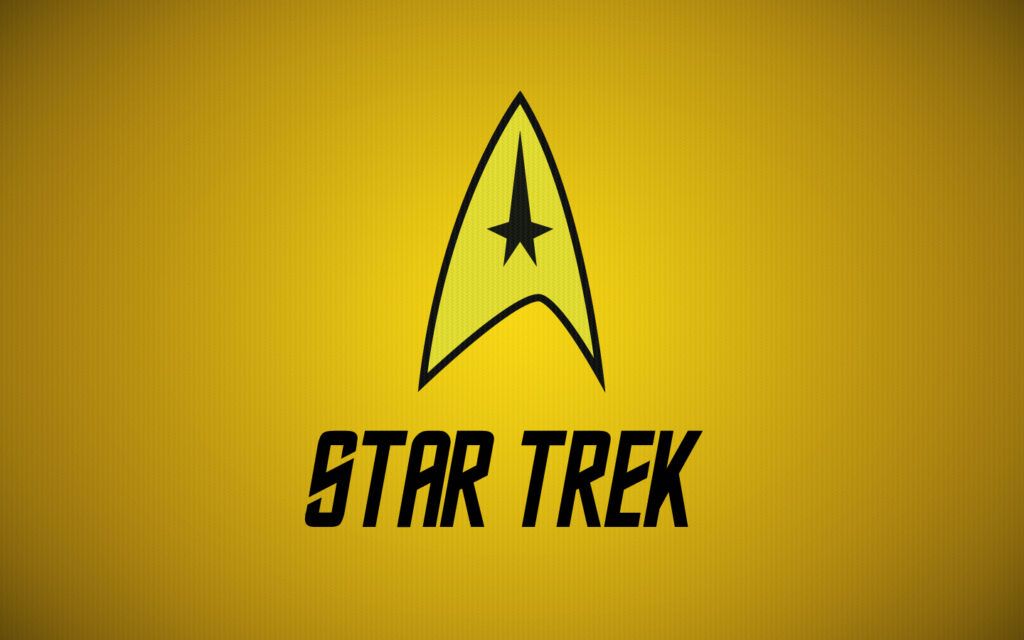
The Enterprise crew receive a distress signal coming from the planet Ekos, a planet which was colonized by a group of humanoids from Earth centuries ago and has since developed its own culture and government. Captain Kirk and Spock take a landing party to the planet to investigate and find that it has been taken over by Nazis.
Upon arriving, they discover that the planet has been transformed to reflect Nazi Germany, complete with flags, uniforms and even the infamous salute. The leader of Ekos, John Gill, has adopted the persona of Nazi leader Adolf Hitler and has declared himself Führer. He has also instituted a policy of racial segregation to keep the native humanoid population, the Zeons, under control.
Kirk and Spock are appalled by the situation and discover that the signal they had received was actually sent by a group of Federation-aligned Zeons who are trying to fight back against the Nazi regime. However, their efforts have been thwarted by the powerful Ekosian security forces.
Meanwhile, the Enterprise crew discovers that the Nazi takeover was engineered by an alien species known as the Klingons. They had been supplying the Ekosian government with weapons and technology, and had even developed a “pattern of force” program to ensure that the Nazi ideology would be adopted by the population.
Kirk and Spock decide to launch a covert mission to disrupt the Klingon’s program. They enlist the help of the Zeon rebels and set out to take down the Klingons’ control center. Along the way, they enlist the help of a group of Federation-aligned Zeon scientists, who have been working on a way to counteract the Klingons’ program.
The rebel mission is a success, and the Klingons’ control center is destroyed. However, the Nazis still remain in control of Ekos. Kirk and Spock devise a plan to use the Zeon scientists’ technology to disrupt the Nazi’s control and liberate the planet.
They launch an assault on the Nazi stronghold, and with the help of the Zeon rebels, they are successful in overthrowing the Nazis. Gill is arrested, and the Zeons are able to reclaim their planet. In the aftermath, the Klingon’s pattern of force program is rendered inoperable and the planet is finally free.
However, the victory is bittersweet, as the Zeons have been living under decades of oppression and their society has been scarred by the events. The episode ends with a glimmer of hope, as the Zeons begin to rebuild their shattered society. With the help of the Federation, they slowly reclaim their freedom and start to put the pieces of their planet back together.
Related Posts
The conscience of the king, a piece of the action, assignment: earth.
Type above and press Enter to search. Press Esc to cancel.
Patterns Of Force Stardate: 2534.0 Original Airdate: 16 Feb, 1968
<Back to the episode listing
Star Trek ® and related marks are trademarks of CBS Studios Inc . Copyright © 1966, Present. The Star Trek web pages on this site are for educational and entertainment purposes only. All other copyrights property of their respective holders.

Civilizations Based On Earth History In Star Trek: TOS
- Encounters in Star Trek often mirror Earth civilizations; from Roman spectaculars to Nazi influences, the show draws parallels to history.
- TOS writers reused sets and props for alien worlds to reflect Hodgkin's Law; Earth-type planets develop similar civilizations.
- Star Trek explores ethical and political themes; from the Vietnam War analogy on Neural to the totalitarianism on Ekos, each planet's tale has a lesson.
Space, proclaims Captain James T. Kirk of the Starship Enterprise , is the final frontier, an undiscovered place full of groundbreaking discoveries just waiting to be made. While the heroes of Star Trek: The Original Series do meet a variety of strange alien lifeforms during their voyages, other encounters hit far closer to home.
Star Trek: 8 Most Powerful Federation Starships, Ranked
TOS was not afraid to reuse props and sets from other productions when crafting alien worlds. Indeed, Star Trek 's writers even devised an explanation for this practice: Hodgkin's Law of Parallel Planetary Development, referenced in several episodes, states that all Earth-type planets are likely to display similar civilizational arcs. From modern-day Romans to a gangster planet, Kirk gets a taste of home, no matter how far out he explores.
Before The Planet Was Called "Miri," It Was Referred To As "Earth Two"
- "Miri" (Season 1, Episode 8)
Bearing an uncanny resemblance to Earth, the planet Miri is beset by a deadly virus when the Enterprise makes contact. As a result of a science experiment gone wrong, the adult population has died out, leaving the planet under the control of its infant inhabitants. Kirk and his crew soon find themselves not only at the mercy of the children but also suffering from the effects of the planet's disease. However, Dr. McCoy is able to cure the virus, laying the foundations for Miri's return to normality.
Indeed, Miri is so similar to Earth that the planet was not named in the episode's initial script, instead being referred to as "Earth Two." Subsequent Star Trek novels seized on this connection, with one suggesting that Miri was Earth itself, albeit from a different timeline, and another stating that the planet was one of several Earth duplicates created by the ancient Preservers.
Sigma Iotia II
Home to a 1920s gangster civilization.
- "A Piece Of The Action" (Season 2, Episode 17)
Season 2's "A Piece of the Action" sees the Enterprise travel to Sigma Iotia II, a planet located in the Beta Quadrant. Kirk and his colleagues discover that the planet's natives are living like 1920s gangsters from Earth, and they soon determine the cause of this deviation. A century prior, another Federation starship visited the planet, forever altering the course of Iotian history. The ship, Horizon, soon departed, but it left behind an item that changed everything.
Star Trek: The USS Enterprise's Best Commanding Officers, Ranked
The primitive Iotians based their society on a book discarded by Horizon, namely Chicago Mobs of the Twenties . This served as a civilizational handbook, trapping the developing culture in a gangland quagmire. However, Kirk's intervention puts the planet back on the right path.
Offers A Moral Vietnam War Story
- "A Private Little War" (Season 2, Episode 19)
While The Original Series showed an interest in re-purposing ancient history to generate plots, the show didn't shy away from addressing more contemporary themes. In "A Private Little War," the Enterprise becomes involved in a proxy war on the planet Neural. The Klingon Empire is backing one faction on the planet by providing it with advanced weapons; Kirk must intervene to restore balance to the primitive planet.
While Neural lacks the reused sets and props that so often characterize a TOS parallel Earth episode, it serves as the basis for a clear parable about the Vietnam War. This engagement with allegory elevates the story above others in the sub-genre, as it draws on real-world politics rather than simple aesthetics.
Draws Inspiration From Greek Mythology
- "Elaan Of Troyius" (Season 3, Episode 13)
While little is clear about the planet Elas, the circumstances surrounding it and the neighboring world of Troyius are deeply rooted in Earth mythology. Troyius and Elas, both located in the Tellun system, are at war; only a diplomatic marriage between Elaan, an Elasian, and the ruler of Troyius has any hope of ending the conflict.
Star Trek: 5 Deaths That Rocked The Franchise's Foundation
While the Enterprise is assigned to assist with the marriage plans, the hotblooded nature of the Elasians complicates matters. They are a proud warrior race, recalling Earth civilizations like the Spartans, while the episode's title is a space-age twist on Helen of Troy, a figure from Ancient Greek poetry. However, the female Elasians have something that no human has ever possessed: tears that act as a powerful love potion. The Elasians may be rooted in classical antiquity , but they are not entirely derivative.
Reminiscent Of Nazi Germany
- "Patterns Of Force" (Season 2, Episode 21)
Seen in the "Patterns of Force" episode, the planet Ekos is modeled on the Nazi Germany of Earth's twentieth century . Originally a lawless pre-warp world, intervention by a Federation historian transformed the planet by introducing the Ekosians to the principles of National Socialism, somewhat naively believing that this would create an ordered society without any drawbacks.
By the time of the Enterprise's visit to Ekos, the planet has adopted a variety of Nazi iconography and practices. Thankfully, Kirk and Spock are able to remedy the situation on Ekos, hopefully ushering in a less genocidal system of government for the planet's population.
Showcases A Technologically Superior Ancient Rome
- "Bread And Circuses" (Season 2, Episode 25)
"Bread and Circuses" not only finds a way to incorporate the fashions of Ancient Rome into Star Trek 's future but also skewers contemporary network TV production with its televised gladiator battles. The episode features the Enterprise investigating 892-IV, a planet where Roman practices coexist with twentieth-century technology.
The Roman-style society on 892-IV is notable in that Kirk's intervention fails to significantly alter it. Rather than overthrowing the cruel model of government, Kirk and his fellow officers are only able to escape. However, a transmission detected by Uhura suggests the presence of a Christianity-adjacent movement on the planet. The Enterprise's crew concludes that, since the Rome of 892-IV so closely mirrors their own, it too will fall given time.
A Civilization That Adopts The Worst Aspects Of Humanity
- "Plato's Stepchildren" (Season 3, Episode 10)
Today, "Plato's Stepchildren" is best remembered for featuring what is widely (but incorrectly) referred to as television's first interracial kiss. However, the episode is also notable for how it reuses imagery from Ancient Greece in order to create the world of Platonius. This is understandable, as the alien Platonians admit to being heavily inspired by the teachings of Plato and Socrates .
Star Trek: The Fates Of Every Live-Action TV Show's Main Character
Unfortunately, Platonius and its citizens reproduce many of the worst features of Earth's history. They are cruel and petty, choosing to use their telekinetic powers to abuse those whom they consider inferior. Indeed, the Platonian's treatment of Kirk and his crew resulted in the British Broadcasting Corporation's refusal to air the episode on the grounds that it contained sadistic themes. Platonius may be modeled on Earth, but few of humanity's virtues are on display there.
A Civilization That Shares An Almost Identical History To Earth
- "The Omega Glory" (Season 2, Episode 23)
While "The Omega Glory" is widely regarded as being one of the worst episodes of The Original Series , it does introduce the notable world of Omega IV. The Enterprise's visit to the planet uncovers a conflict between the Kohms and the Yangs, a war that is being interfered in by a stranded Starfleet captain.
It is revealed, somewhat implausibly, that Omega IV experienced a nearly parallel history to Earth, although the Cold War on Omega IV escalated into a full-blown conflict. The United States Constitution was also written independently on the planet in what must be Star Trek 's biggest-ever coincidence. With contrivances like these, it's a mercy that "The Omega Glory" was not chosen as Star Trek 's second pilot, although Gene Roddenberry did consider the idea.
Created by Gene Roddenberry
First Film Star Trek: The Motion Picture
First TV Show Star Trek: The Original Series
Creation Year 1966
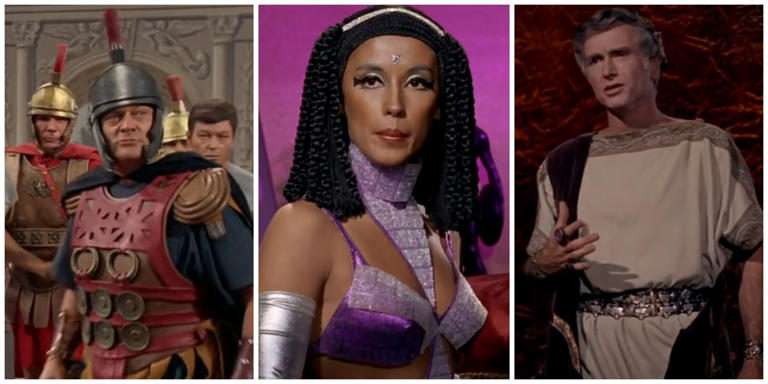
- More to Explore
- Series & Movies
Episode Preview: Patterns of Force

IMAGES
VIDEO
COMMENTS
Star Trek: The Original Series. ) " Patterns of Force " is the twenty-first episode of the second season of the American science-fiction television series Star Trek. Written by John Meredyth Lucas and directed by Vincent McEveety, it was first broadcast on February 16, 1968. In the episode, the crew of the Enterprise tracks down a Federation ...
Patterns of Force: Directed by Vincent McEveety. With William Shatner, Leonard Nimoy, DeForest Kelley, Richard Evans. Looking for a missing Federation cultural observer, Kirk and Spock find themselves on a planet whose culture has been completely patterned after Nazi Germany.
The Enterprise, searching for a missing Federation historian, discovers that the historian has apparently contaminated the cultural development of the planet where he was assigned as a cultural observer to have it follow the societal path of Nazi Germany in the 1930s and '40s. The USS Enterprise heads for the planet Ekos to locate a missing cultural observer, Professor Dr. John Gill, Ph.D., a ...
"Star Trek" Patterns of Force (TV Episode 1968) cast and crew credits, including actors, actresses, directors, writers and more. Menu. ... Best Episodes - Star Trek TOS a list of 36 titles created 02 Mar 2021 My Favorite Star Trek The Original Series Episodes!! a list of 42 titles ...
Includes all episodes of Star Trek: The Original Series, The Animated Series, The Next Generation, Deep Space Nine, Voyager, Enterprise, Discovery, Picard, Lower Decks, Prodigy, and Strange New Worlds. Also, Star Wars, the new Battlestar Galactica, and The Orville. ... "Patterns of Force"—in which Kirk, Spock, and Bones beam down to a planet ...
Upload, livestream, and create your own videos, all in HD. This is "TOS - S02E21 - Patterns Of Force" by erte on Vimeo, the home for high quality videos and the people who love them.
Patterns of Force. Stardate 2534.0: The Enterprise is sent to planet Ekos to investigate a disappearance of Federation historian John Gill. Arriving at the planet Ekos, the Enterprise is fired upon by atomic missiles, although records indicate that the planet does not possess such technology. Kirk and Spock beam down to investigate.
"Patterns of Force" is the twenty-first episode of the second season of the American science-fiction television series Star Trek. Written by John Meredyth Lucas and directed by Vincent McEveety, it was first broadcast on February 16, 1968.
Star Trek: The Original Series Patterns of Force Sci-Fi Feb 16, 1968 48 min Paramount+ Available on Paramount+, Prime Video, iTunes S2 E21: Enterprise is sent to planet Ekos to investigate a disappearance of Federation historian John Gill. Sci-Fi Feb 16, 1968 48 min Paramount+ ...
Star Trek S2 E21 "Patterns of Force". Ironically, the only blonde person here isn't a Nazi. Original air date: February 16, 1968. The Enterprise crew are headed off to the planet Ekos to pick up famed cultural observer John Gill, with whom the Federation has lost contact for some time.
"Patterns of Force" was the 52nd episode of Star Trek: The Original Series, the 23rd episode of the show's second season, first aired on 16 February 1968. The episode was written by John Meredyth LucasMA, directed by Vincent McEveetyMA and novelized in Star Trek 12 by James Blish and J.A. Lawrence. James T. Kirk, Spock and Leonard McCoy must stop a Nazi-like invasion of the planet Zeon by ...
Star Trek; About; Back to video . Search ; Sign Up. Sign In; Shows ; Movies ; Live TV ; Sports ; News ; Showtime ; Menu. Sign up for Paramount+ to stream this video. TRY IT FREE . Patterns of Force. Help. S2 E21 50M TV-PG. Enterprise is sent to planet Ekos to investigate a disappearance of Federation historian John Gill ... Patterns of Force ...
Season 2, Episode 21 On a planet that mimics Nazi Germany, Kirk and Spock search for a missing observer.Be sure to check out "30+ Rare Finds From Star Trek ...
(Note: If you haven't read it yet, my introductory post on this Star Trek: The Original Series rewatch is a good place to start.) Original Air Date: February 16, 1968 Crew Death Count: 0 Bellybuttons: 2 (Kirk and Spock get topless in prison) It would be tempting to call "Patterns of Force" the lowest moment of the original series, if we didn't still have "The Omega Glory" to suffer ...
Looking for a missing Federation cultural observer, Kirk and Spock find themselves on a planet whose culture now models the German Nazi Party of old Earth in...
Episode Title: 'Patterns of Force' ... Star Trek: The Original Series - The Complete Second Season' DVD - Amazon.ca 'Star Trek: The Original Series - Season 2' DVD - Amazon.co.uk
Opinionated Star Trek Episode Guide visits the planet of the Nazis. Seriously, they even have the same uniforms, things were really nutty back in the sixties.
Check back daily for the latest review. Patterns of Force is a rather strange little episode, the type of weird and iconic adventure that Star Trek tended to do quite well. It's very much an off-the-wall adventure, of the kind that none of the spin-off shows would attempt. "Planet of the Nazis" is a concept that belongs alongside other ...
Patterns of Force The Enterprise crew receive a distress signal coming from the planet Ekos, a planet which was colonized by a group of humanoids from Earth cen ... Choose Your Star Trek Series. The Original Series; The Next Generation; Deep Space Nine; Voyager; Enterprise; Discovery; Picard; Strange New Worlds; Choose By Year. 1966; 1967; 1968 ...
Patterns Of Force Stardate: 2534.0 Original Airdate: 16 Feb, 1968. [Bridge] (The Enterprise is gliding past a red planet towards a blue one.) SPOCK: Passing outer planet, Zeon. KIRK: We want the inner one, Ekos. Plot a standard orbit, Mister Chekov, and take us in. CHEKOV: Aye, sir. KIRK: Lieutenant Uhura, raise John Gill on Starfleet ...
Patterns of Force. Patterns of Force may refer to: "Patterns of Force" (Star Trek: The Original Series), an episode of Star Trek: The Original Series. Patterns of Force (novel), a Star Wars novel. This disambiguation page lists articles associated with the title Patterns of Force. If an internal link led you here, you may wish to change the ...
Seen in the "Patterns of Force" episode, the planet Ekos is modeled on the Nazi Germany of Earth's twentieth century. Originally a lawless pre-warp world, intervention by a Federation historian ...
© 2023 CBS Studios Inc., Paramount Pictures Corporation, and CBS Interactive Inc., Paramount companies. STAR TREK and related marks are trademarks of CBS Studios Inc.
56:29. Star Trek The Original Series S01E05 The Enemy Within [1966] Star Trek The Next Generation. 56:23. Star Trek The Original Series S02E26 Assignment Earth [1966] Star Trek The Next Generation. 57:50. Star Trek The Original Series Season 2 Episode 23 The Omega Glory [1966] Star Trek The Original Series.
Best Buy has honest and unbiased customer reviews for Star Trek: The Original Series, Vol. 26: Return to Tomorrow/Patterns of Force [DVD]. Read helpful reviews from our customers. ... Return to Tomorrow/Patterns of Force [DVD] SKU: 4215637. User rating, 4.8 out of 5 stars with 38 reviews. 4.8 (38 Reviews) $17.99 Your price for this item is $17. ...